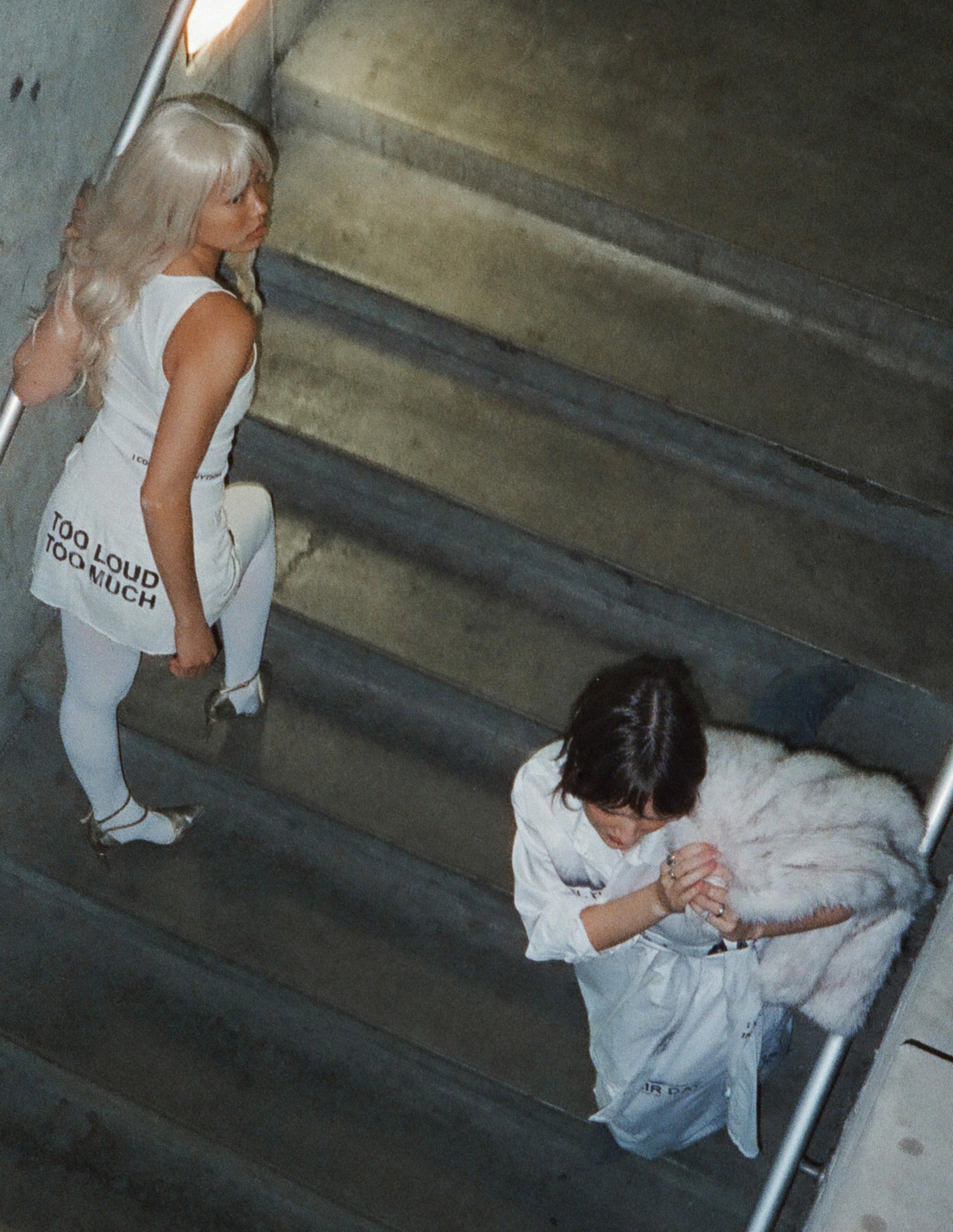
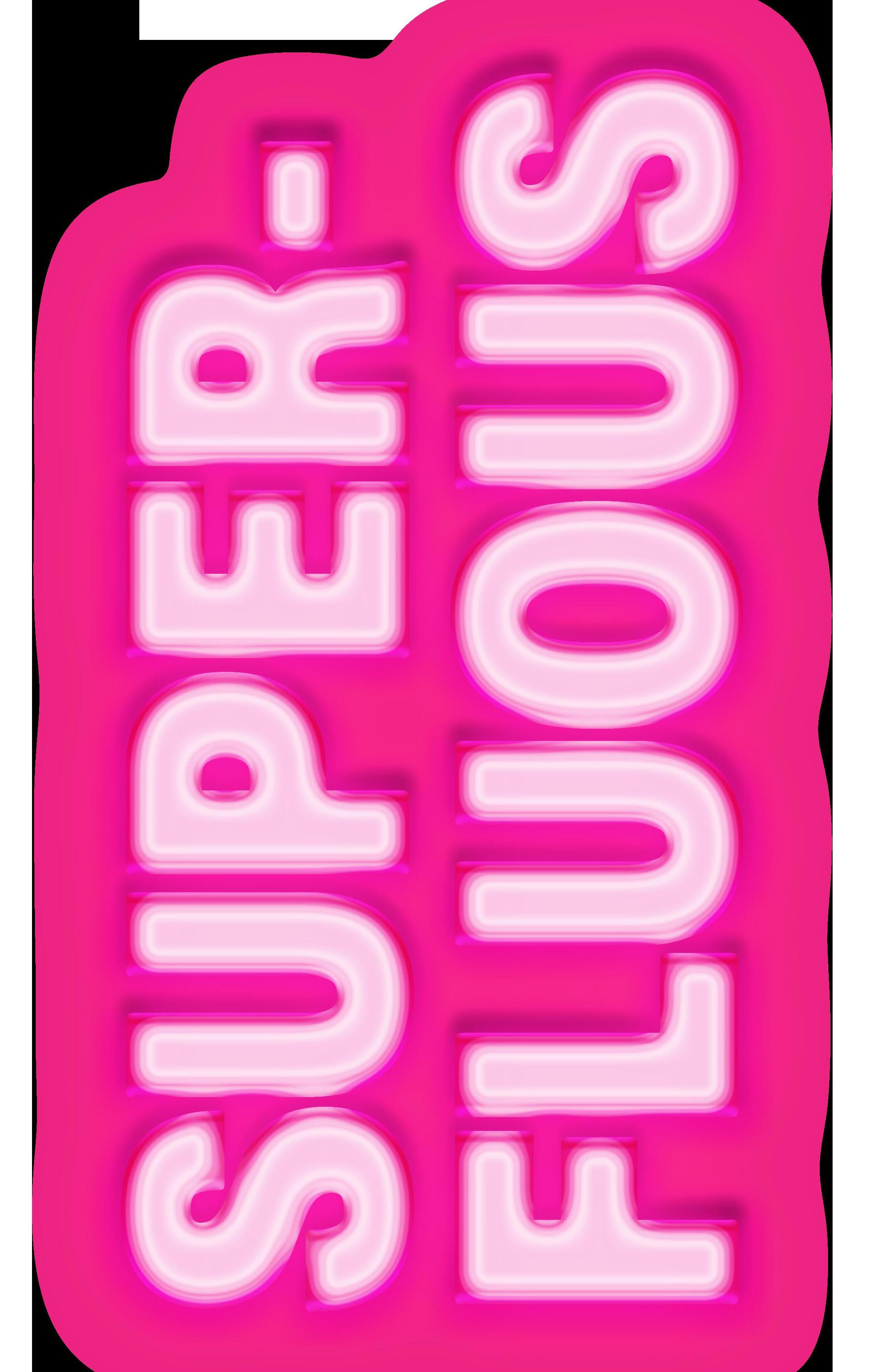

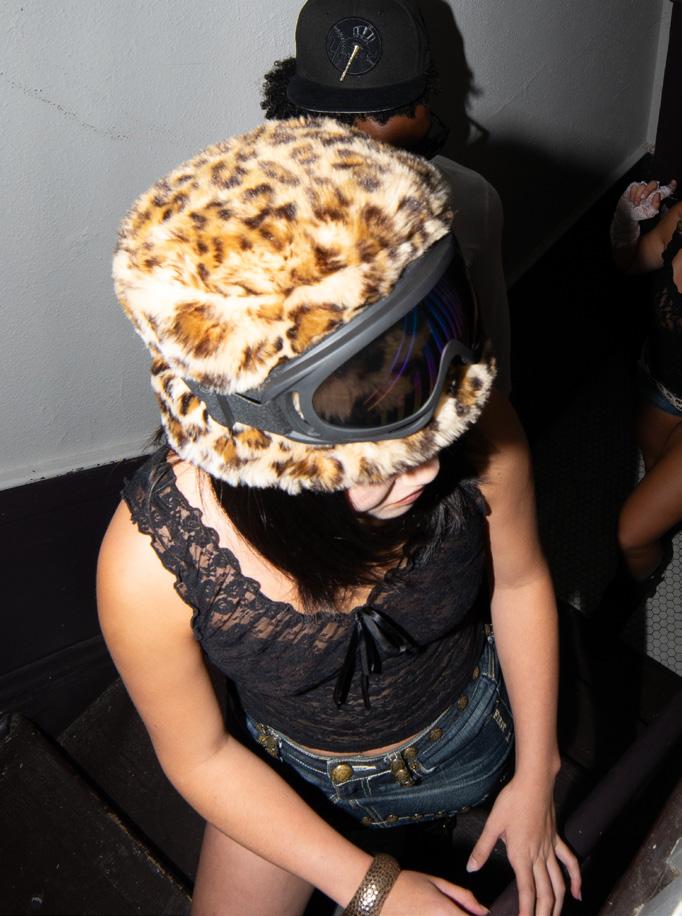

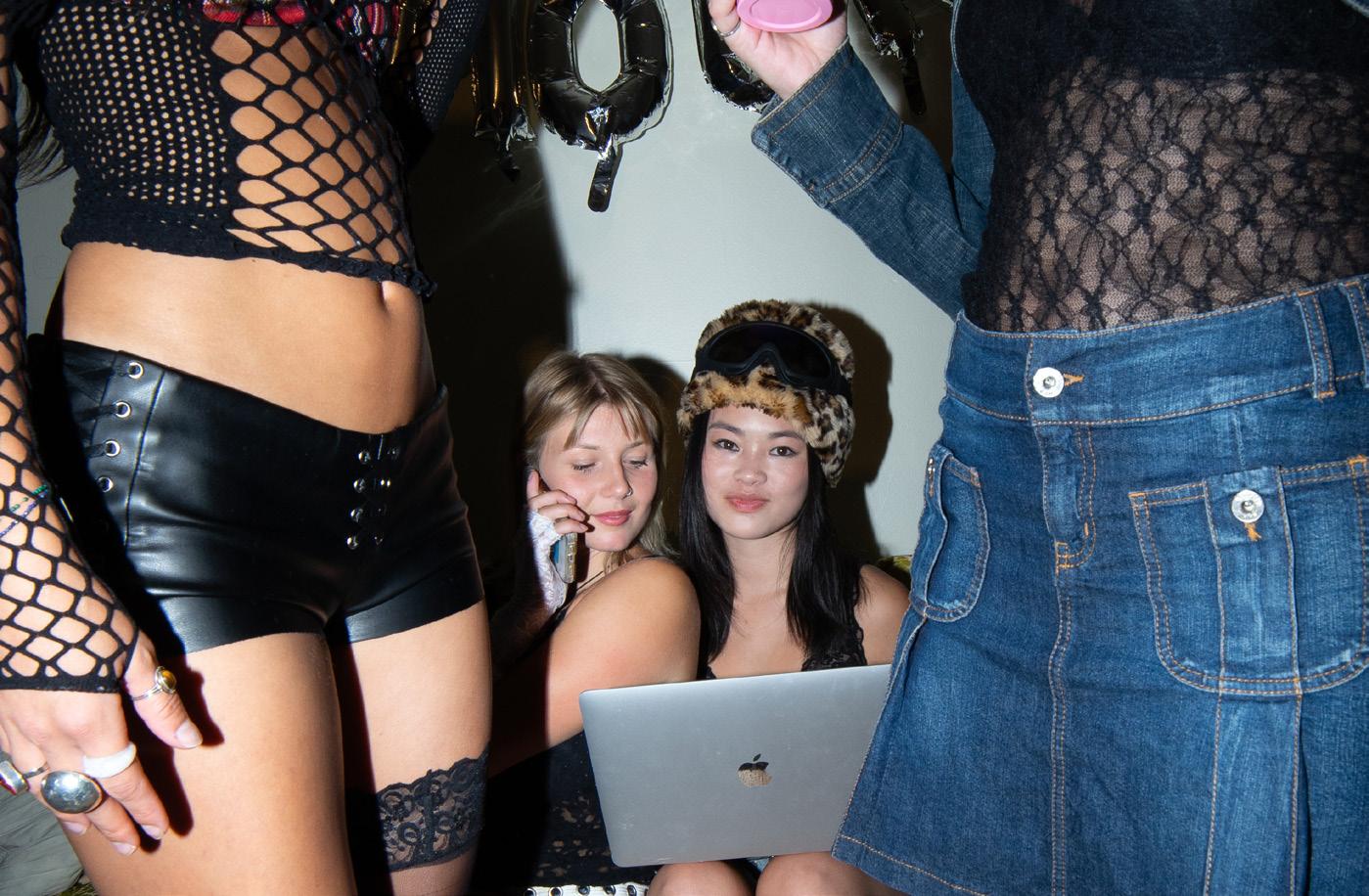







In a world that is becoming increasingly homogenous—where people challenge anything extra, where trends are bought and sold, where styles and personalities converge into sameness, where our world grows ever more interconnected — we asked ourselves, and tasked ourselves, to dig into the ideas and objects we often toss aside out of fear of judgment for being “too much.”


We tapped into those ideas that had been set aside and explored the maximalist, the excessive, the very, very, very unnecessary accessories, the magical moments, and the intrinsically inordinate items. Superfluous entails everything that is more than enough, unnecessary, and extra.
Across these pages, we celebrate the idiosyncrasies that make up our own wacky worlds. Superfluous, to the naked eye, may often be written off as goofy, funny—and sometimes, it often is. Maybe our superfluous natures have been shaped by insecurities and fears, our pasts, and what we’ve seen. Sometimes it’s scary to be vulnerable with these sides of ourselves.
But here, Armour is a realm of creativity and a homeplace for all that is unusual, fantastical, or just plain kooky. It is a celebration of the misfits, those who are on their own wavelength—always three steps ahead of the crowd.
We invited Amourites to probe not just the goofy but also the sentimental, to let their guards down. In short, we asked them to explore the superfludom. We took on the role of Sherlock Holmes in our pursuit to understand the superfluous mysteries of people’s lives. From anthropological reports on tchotchkes, to the stray thoughts bubbling up in our brains, to the celebrities wandering our campus, we traced the trails they might leave behind—in their doodles, their collections, or the ink on their skin that quietly asks to be noticed and carefully read.


We owe a huge thank you to our staff, who worked so diligently and thoughtfully to handle these ideas, practices, designs, and clothes with such care. Superfluous and superfludium are delicate topics, and we are endlessly grateful to this crew for celebrating and carrying this issue with love. We hope that Superfluous resonates with those who feel their essence borders on the ridiculous, and reminds us above all to have a little fun with life—especially in the form of accessories.
Stay extra. Stay superfluous.
Sincerely,
Bri, Sophia, and Yabsera 2024–2025 Editors-in-Chief


THESE GIRLS DIDN’T COME TO PLAY!



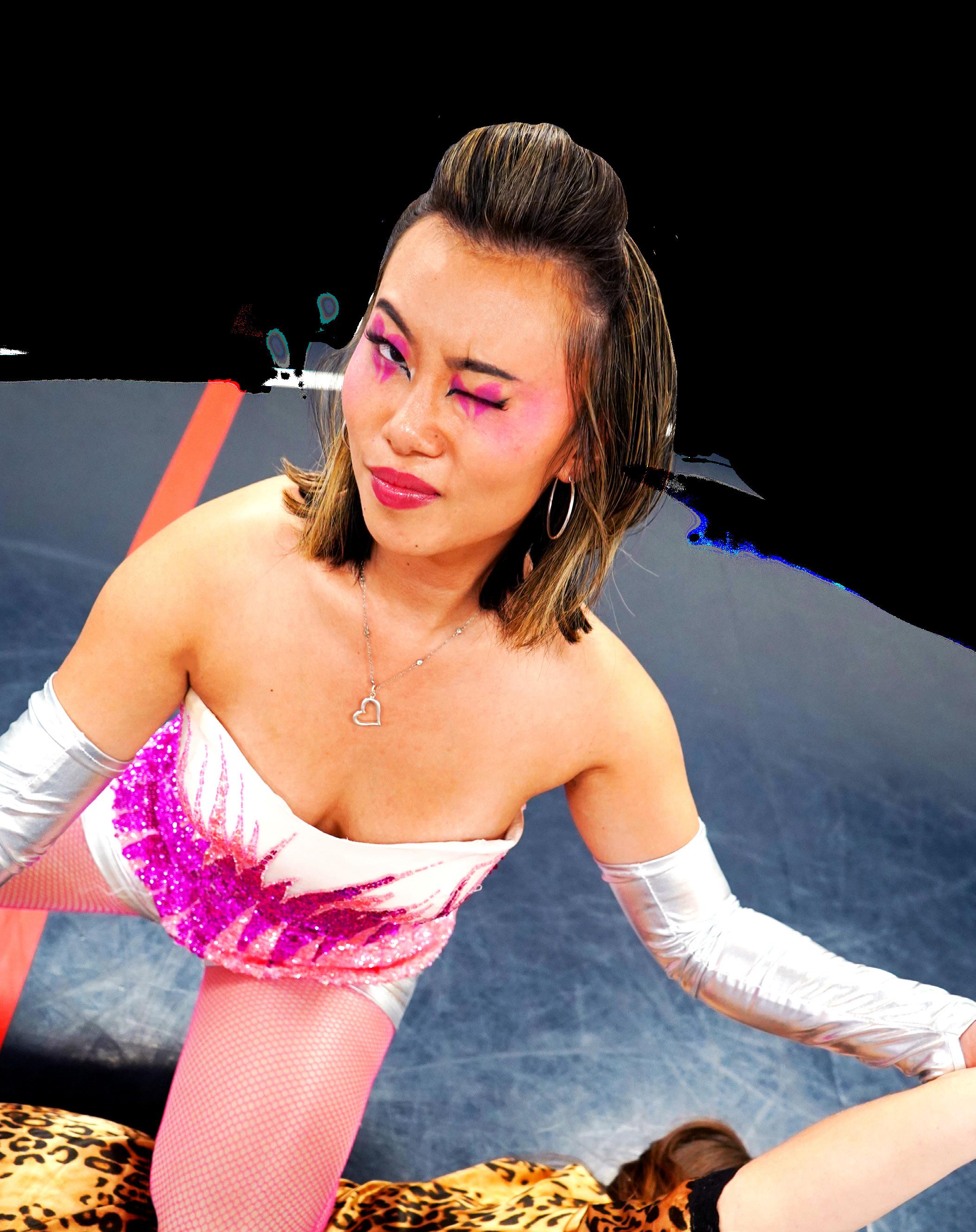


South Broadway, in the heart of Soulard was founded in 1899, and has become a fixture of its neighborhood. Since its inception the club has offered the community wrestling events, concerts, sports leagues, and is even open to the public once a week. If you want to try your hand at wrestling, it’s the place to go. Last


Suede, with David Bowie’s “Fame” for his walk into the ring. Wrestlers lept from the ropes onto the stage, which clattered and shook as if it was suspended on tired springs. They towered over the crowd, hurling both their insults and their bodies at their opponents. Sophie and I were aghast! The athleticism required for these bouts was more than we could have imagined. The audience was engrossed in the performance, and many evidently attended this event on a monthly basis. Fan favorites included Warhorse and Dan the Dad, who challenged one another to a street fight that was promptly scheduled for the next month!
curtain from which the wrestlers would soon emerge. As the house lights went down and the spotlights came up, the crowd around us began to rumble. Lights swung down to the curtains, and the and the wrestlers emerged to raucous applause. Each new wrestler had their own entrance song, most memorably September, Sophie and I had the opportunity to visit the club ourselves. We drove down to Soulard on a Sunday afternoon, and after stopping to greet a nearby bar’s pet cat, went up the small flight of stairs into the SBAC. As we took stock of the wooden floors, the lofty ceilings, and the smell of nacho cheese that filled the air. The real showstopper was the four-foot tall platform stage at the center of the cavernous room. Over the course of the next three hours, six separate wrestling matches would happen on that stage. We found seats in the rows of chairs that lined the sides of the stage, positioning ourselves next to the

















As we watched the second round of fighting, Sophie and I made the acquaintance of a photographer who introduced himself as Boombox Rob. He had noticed that Sophie had been taking photos, and came over to see what she was doing.
“‘Is that your legal name?’” I asked, “‘Boombox Rob?”’
Boombox Rob just chuckled, and assured me, that’s what everyone calls him! He then inquired if we were there with wrestlers. We assured him we were not, but he didn’t seem to believe us.
‘“I’ve
‘“Are you here every time?’’



‘“No,”’
Sophie said, ‘“We’re journalists!”’
‘“We’ll be reimbursed by the publication,‘“ I said.
never seen you here before,’’ he said. He confirmed that yes, he came to every event, and began checking the settings on Sophie’s camera to accommodate the LED lights. Boombox Rob then handed Sophie his expensive Sony camera, told us to take some photos, and said he would be right back. When he returned, came here for fun,’”






‘“What’s the publication?‘“
‘“The New York Times!‘“










BOOMBOX ROB DIDN’T BELIEVE US!


Rhiannon doesn’t care what you think. And she’s not afraid to say so. Known for a verbal
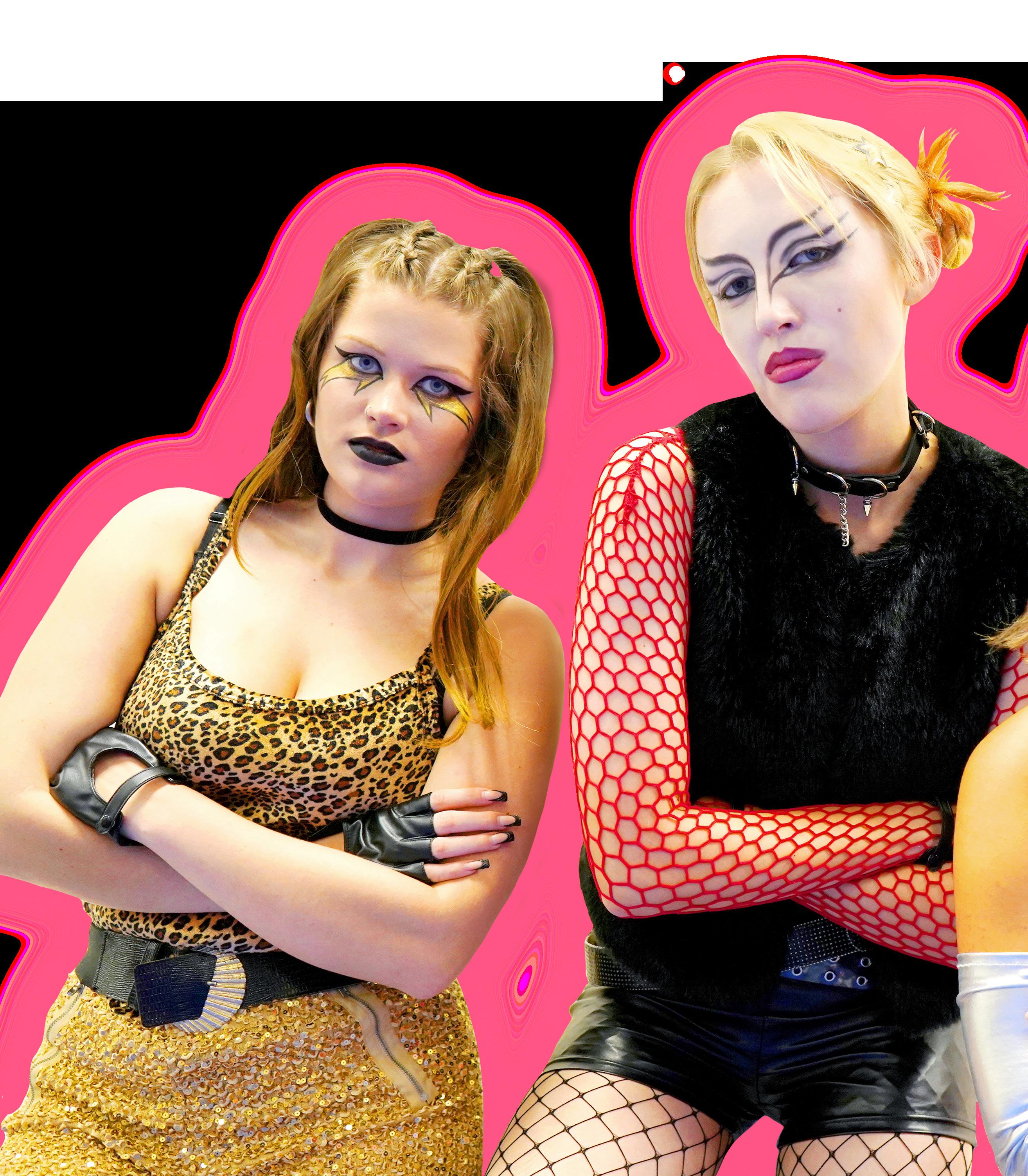

She’ll
eat your heart out & then leave it in the ring. Deceivingly

We watched the next round of wrestling, then Sophie and I made our way to the exits. We stopped to say hello to the cat one more time, and then headed home. Later on I caught up with Blair Onyx, one of the wrestlers from the event, to find out more about her career as a professional wrestler.
Collins: How did you get started in wrestling,
So, I started wrestling actually in the summer of my junior year of college. I was in university, but I just knew I liked it, and I couldn’t let it go, like I wanted to wrestle. I had watched wrestling ever since I was a little kid, so it was something I dreamed about, but I honestly didn’t think it was that realistic.
Collins: How did you develop the character
Well, there were some parts of Blair Onyx that I always had. When I started wrestling, I had an idea of what I wanted my look to be, more than like, a character at first. I knew I wanted to do a darker aesthetic, it’s what I was drawn to. I train at Freelance now, with a lot of people just entering the wrestling world, and I always tell them, “you have to be like, an extension of yourself.” It has to become organic. You have to look at yourself, and think about things like, what’s my look, what kind of character do you think would sense, and what fits me. Because a lot of the time, if you fit the look that you’re

















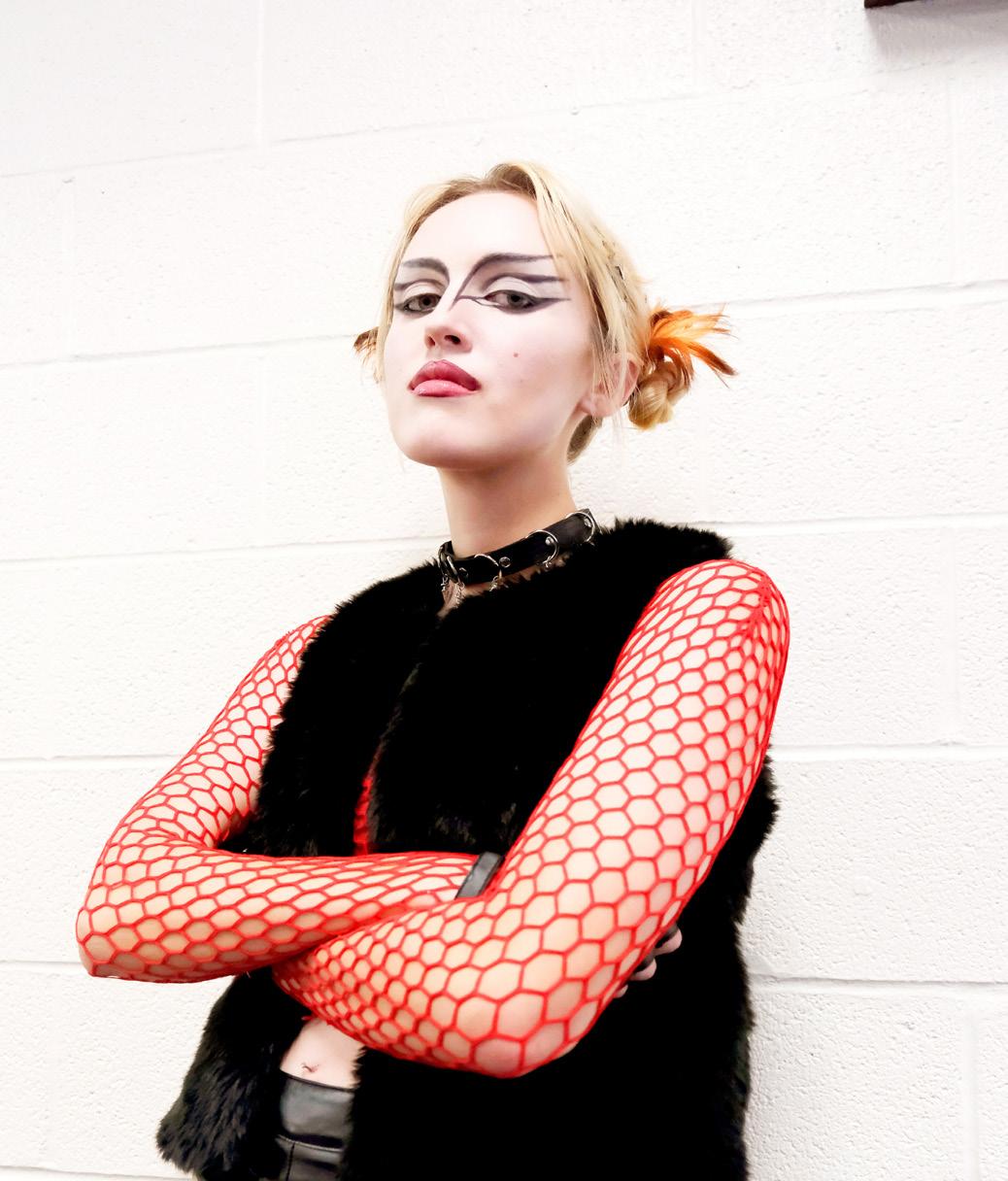
going for, it comes off as authentic. It comes off as something the audience can connect to. It’s the same with the mannerisms, and how your personality is. They always say that who you are in the ring is like your personality, times ten. And I really think that’s true. If you have an element of your character that’s actually you, and you’re just feeding off of it, it becomes a lot easier to know what kind of character you want. I also want to say that it’s also good to scope out who is doing what already, and do your research on wrestling, in the independent scene and on TV. Because you don’t want to copy someone else’s thing directly. Or if you do something inspired by someone’s character…I’m not gonna say I’m the first spider ever, I’m totally not. But I do think you need to find a way to make it uniquely your own, so that you both are bringing different things to the table. As wrestlers, we have a choice. You can be upset and be like; “Oh my gosh they’re stealing my thing,” but also it can be a motivator for us to evolve and change ourselves. Or, how can I grow myself to be distinct? It is just like a business when you think about it.
Collins: It’s like method acting, in a way.
Onyx: Yeah, we’re all trying to market a distinct brand. When I think about wrestling and I think about shows where people don’t know who I am yet, like what am I gonna do, in the little time I have on the show, to make these people remember me? I think that a lot of the time, people won’t remember what moves I hit in my match, but they’ll remember the spider girl that does the backbend.
Collins: Right.
Onyx: That’s memorable.
Collins: I remember that, that was crazy.
Onyx: I think that’s such a good way to think about wrestling, especially when you’re new.
What can you do to stand out, amongst all the wrestlers that are gonna be on the show too? And, that’s where your money is! That’s your market.
Collins: How do wrestlers balance ensuring one another’s safety, while also being as realistic and entertaining and dramatic as they are?
Onyx: I think a lot of times when they’re newer, people are scared to hurt each






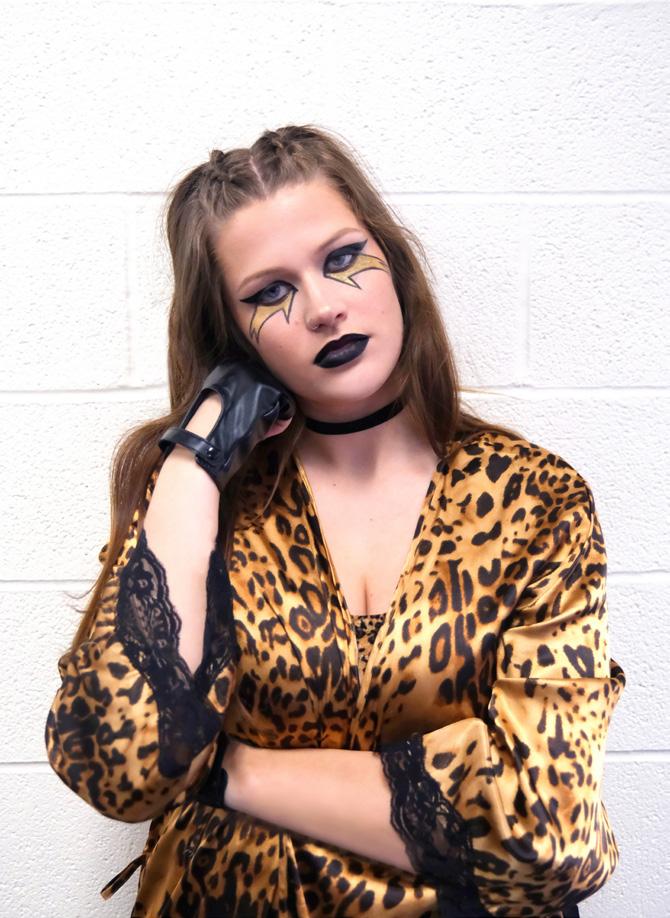





















































a lot of trust that goes into doing what we do. Especially with our opponents, and we are giving them our bodies and I would hope that they put in the work before, to do everything safely. I really do think being hit hard is one thing, that’s the point right? We’re supposed to suspend the disbelief of the viewer. And so, I expect them to do that. But at the same time, if things are not how they’re supposed to be, and you are hitting super hard, it comes off as reckless. That’s when you can get a bad name for yourself. So, it’s always just better to do the work and practice and try hard right?
Collins: What legacy do you hope to leave in the world of professional wrestling, or independent wrestling?
Collins: I know, that’s a big one.
Onyx: Ah! I hope that if anyone ever looks up my stuff, I hope they’re not scared to think outside of the box and be creative. Try different things. I love the idea of characters in wrestling, and the idea of investing an audience through the story. And I hope that one day, when I’m done wrestling, and when sometimes people watch my stuff, they can be inspired to think of what makes them excited, and what story they want to tell the audience. I also would love to inspire future wrestlers. I see a lot of little girls that come up to me and say that they want to be a wrestler one day.
Collins: Aw, that’s awesome!
Onyx: That was literally me when I was a little kid. And so, to have full circle moments like that… I want to leave a positive impact on people and their careers. Especially in the beginning. I want to help people like people helped me. I really want to give back, & I want to have the resources to give back.
Collins: Thank you so much.
Onyx: Of course!


















































The first thing I learned about my college was not about her intended major, how many siblings she might have, or what type of music she listens to. It was about her stick-and-poke tattoo, placidly sitting on her
roommate during my freshman year
inner right ankle.
“It’s
what I would sign off on all of the graffiti art I did during Covid. Kind of like my signage,” she proudly presented to me, hoisting her leg on our shared ottoman. I peered over to see a small asymmetrical heart with two dots for eyes.
The history of tattoos is long and varied, with evidence of the practice dating back thousands of years. One of the oldest examples, Ötzi the Iceman, is a mummy from 3300 BCE with 61 tattoos believed to have a therapeutic and pain-relieving purpose. Ancient Egyptians adorned themselves with tattoos for spiritual protection, while Polynesian cultures developed intricate designs to signify status, lineage, and milestones. Across cultures, tattoos have always been more than decoration—they’ve been markers of identity and history.
My roommate’s stick-and-poke isn’t just a quirky pandemic-era trend; it’s rooted in history and tradition that spans millennia. Today, tattoos continue to connect us to the past while carving out space for self-expression in the present. Whether they celebrate loved ones, mark milestones, or simply express creativity, tattoos often hold deeper meanings than meets the eye. This editorial will dive deep—skin-deep—into the art of tattoos through conversations with college students, St. Louis locals, and tattoo artists.
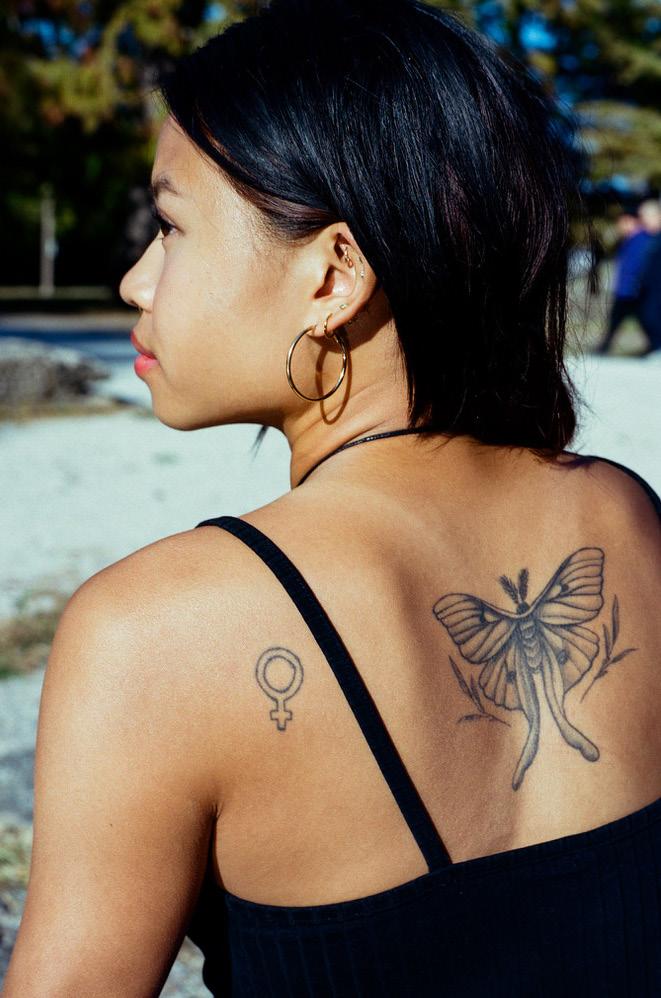
Each tattoo is a snapshot,
MiaMia, a college student, relationship with tattoos began at 18, following a series of piercings. Her first three tattoos held deep meaning, her first to honor her grandmother, but over time, she embraced a more spontaneous approach. “Now, it just looks cool,” she laughs, viewing her tattoos akin to accessories that adorn her body.
Her favorite piece is a moth inked on her back, a design she stumbled upon on Instagram. For Mia, tattoos are about capturing moments. “It’s like a scrapbook,” she describes. “This reminds me of a time in my life.” Each tattoo is a snapshot, a visual diary entry.


a visual diary entry.

For Nikole, tattoos are more than art or decoration—they’re a lifeline for those seeking healing and self-acceptance. Starting her journey in 2009 as an apprentice tattoo artist, she built deep, familial relationships with her mentors. However, she noticed a gap in the industry: the lack of recognition for cosmetic and paramedical tattooing. Determined to fill this void, she opened her own studio in 2019, aptly named “Arch Nemesis.”
Nikole specializes in paramedical tattoos. More specifically, she offers services like recreating eyebrows for those who have lost them due to burns or illness. Her approach ensures that each thin line is precise (even the slightest error can alter the intended design!) “I love helping people,” she shares. “It’s the drive behind everything I do.”



At 55, Tracy decided it was time



At 55, Tracy decided it was time for a change. Something new—perhaps a new version of himself. Without a concrete plan, he decided to reinvent himself with the help of tattoos, starting with a mandala. “It’s a human thing to do, to decorate the body,” he muses, reflecting on the history of body art.
For Tracy, getting tattooed was an exercise in trust and letting go. “Trusting someone else to put something permanent on my body is the opposite of ‘I control my own body,’” he explains. He sees himself not as the artist or the observer but as the curator of someone else’s artwork. One of his favorite pieces features a lighthouse and the phrase “push the boat out,” symbolizing his belief that “nothing is going to happen on the shore.” Placed on the back of his calves, it’s both a personal reminder and a conversation starter.
Tattoos have also altered how Tracy interacts with the world. “People say, ‘Love your tats,’ and it’s unearned attention but validating,” he says. His tattoos act as a social filter, attracting like-minded individuals who appreciate this form of art.
for a change.
Everyone has a story to share.


Some are told verbally, others, visually. Tattoos are more than superfluous accessories – they reveal what it means to be human. It’s human nature to want to feel beautiful, to feel recognized, and to feel loved.

“Don’t
I think a lot of us live on the edge, trying to reconcile the past with the present, and with the future. We are stranded in the middle of a cliff–the top is too far to be reached, but at the same time, we are too high up to return by the old path. We are stalled in relationships–our friends are neither intimates who listen to and understand our struggles, tolerate our temperaments, and celebrate our success nor pure acquaintances.
Breanna hates needles but owns a tattoo pen to tattoo herself. Breanna thinks getting tattooed is painful but sometimes gets tattoos to relieve pain. A lot of Breanna’s tattoos are for covering up previous tattoos. We live in a world of contradictions. We seem to like contradictions.
But what we can’t contradict is our love for our family. Like all mothers, Breanna can be overwhelmed by her young, attached, and high-energy sons. But we can see the names and birthdays of all four of Breanna’s sons in permanent ink on her arms, fingers, and sides of her face. We keep our loved ones near.
Styling
Reid McVey
Makeup
Olivia Slemmer
Art Director
Cece Milde

Creative Directors
Reid McVey & Emily Blake
Models
Rachel Solomon & Aneesah
Rivera-Nichols & Selah
Pabon & Tatum Goforth
Layout
Sophia Palitti
Photography
Sofia Huitron & Ryan Yin
Writing
Genavieve Zermeno
Art Development
Naomi Chao

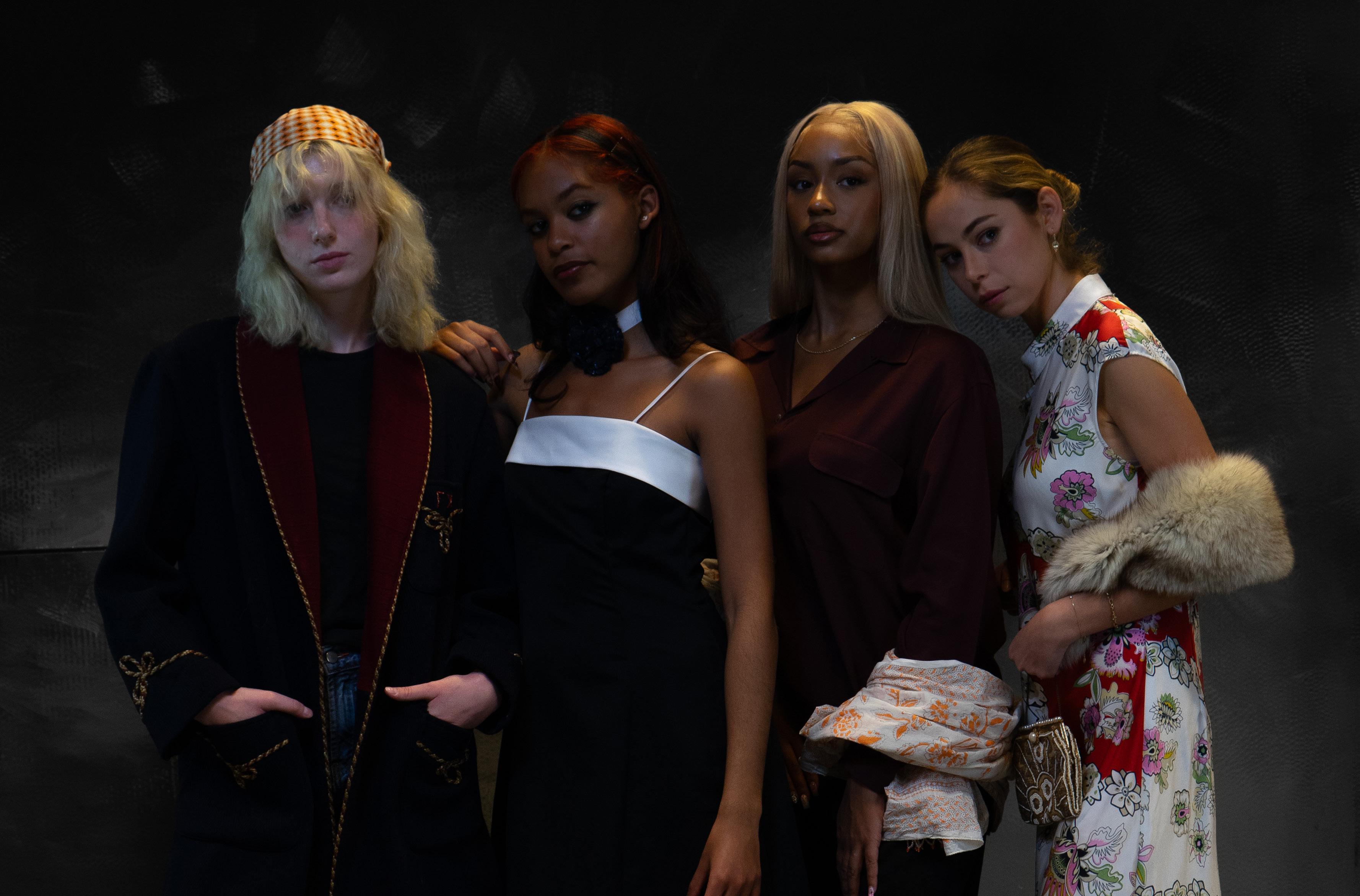

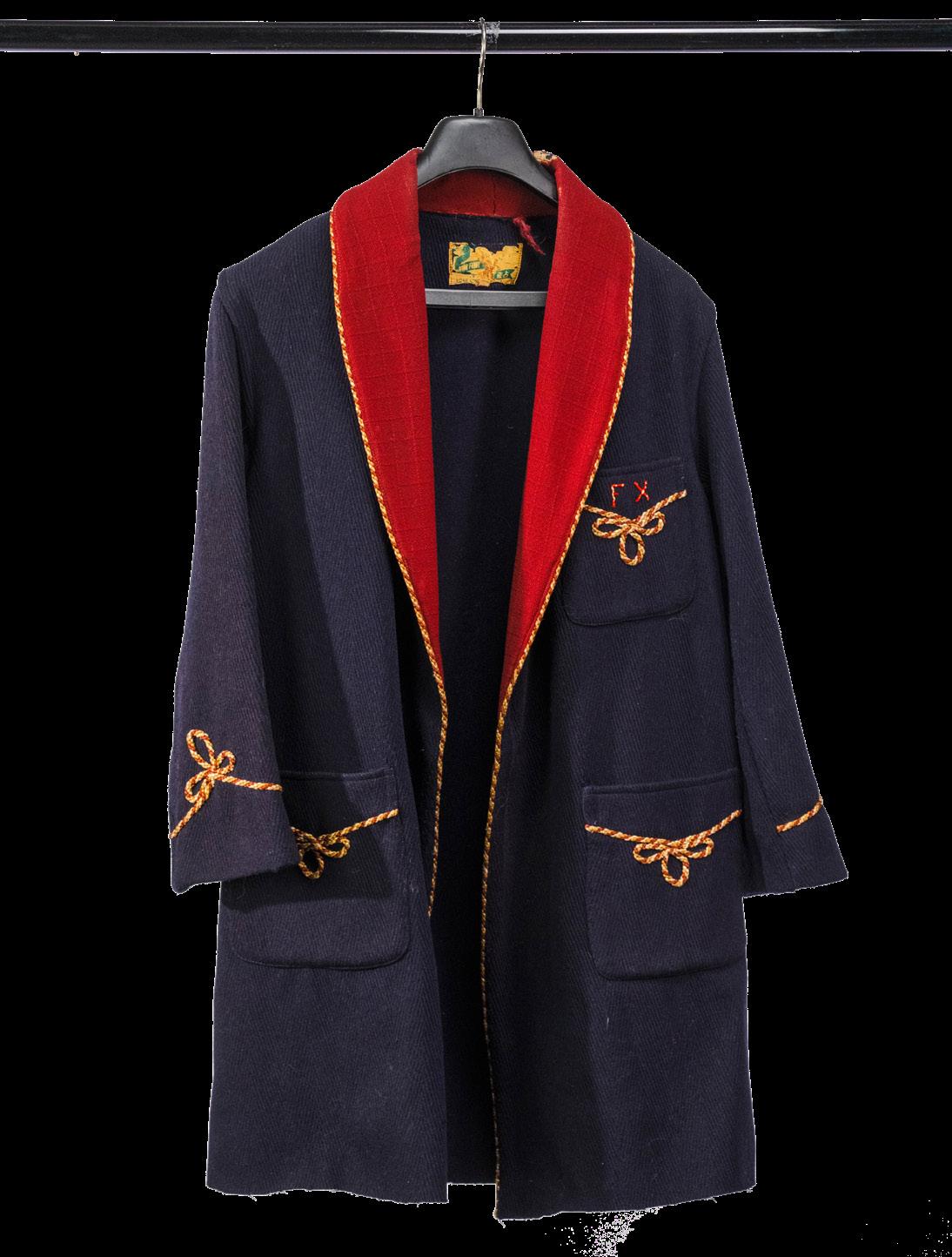

Wool smoking jacket with braided gold and orange detail. With monogram “FX”
Sourced by Desert Vintage, NYC
Up for admiration, and perhaps the most discerning bidder, this epitome of chic tailoring, a true relic from the days when the faintest whiff of opulence meant being draped in luxury just to light up a cigar! Here we present an authentic, early 20th-century wool smoking jacket, intricately adorned with braided gold and orange detail that whispers tales of indulgent evenings. With origins steeped in exclusivity and the art of sophistication, smoking jackets of the 1920s were designed not just to ward off the potent aroma of cigars but to elevate the ritual of the post dinner tête-à-tête to a ceremonial dance. And oh, did they ever do so with flair.

This rare find, sourced by Desert Vintage in New York, boasts the kind of craftsmanship that makes modern tailoring seem rushed and harkens back to the lavish indulgences of the 1920s—an era when the hum of jazz mingled with the clink of highball glasses. The lush red lapels dare you to question whether elegance has ever really moved on from such timeless detailing. This singular creation boasts a monogrammed “FX,” perhaps hinting at a story of some former gentleman who relished his nightly cigars while cloaked in this very masterpiece. This jacket whispers of roaring opulence and a bygone era where leisure was an art form.
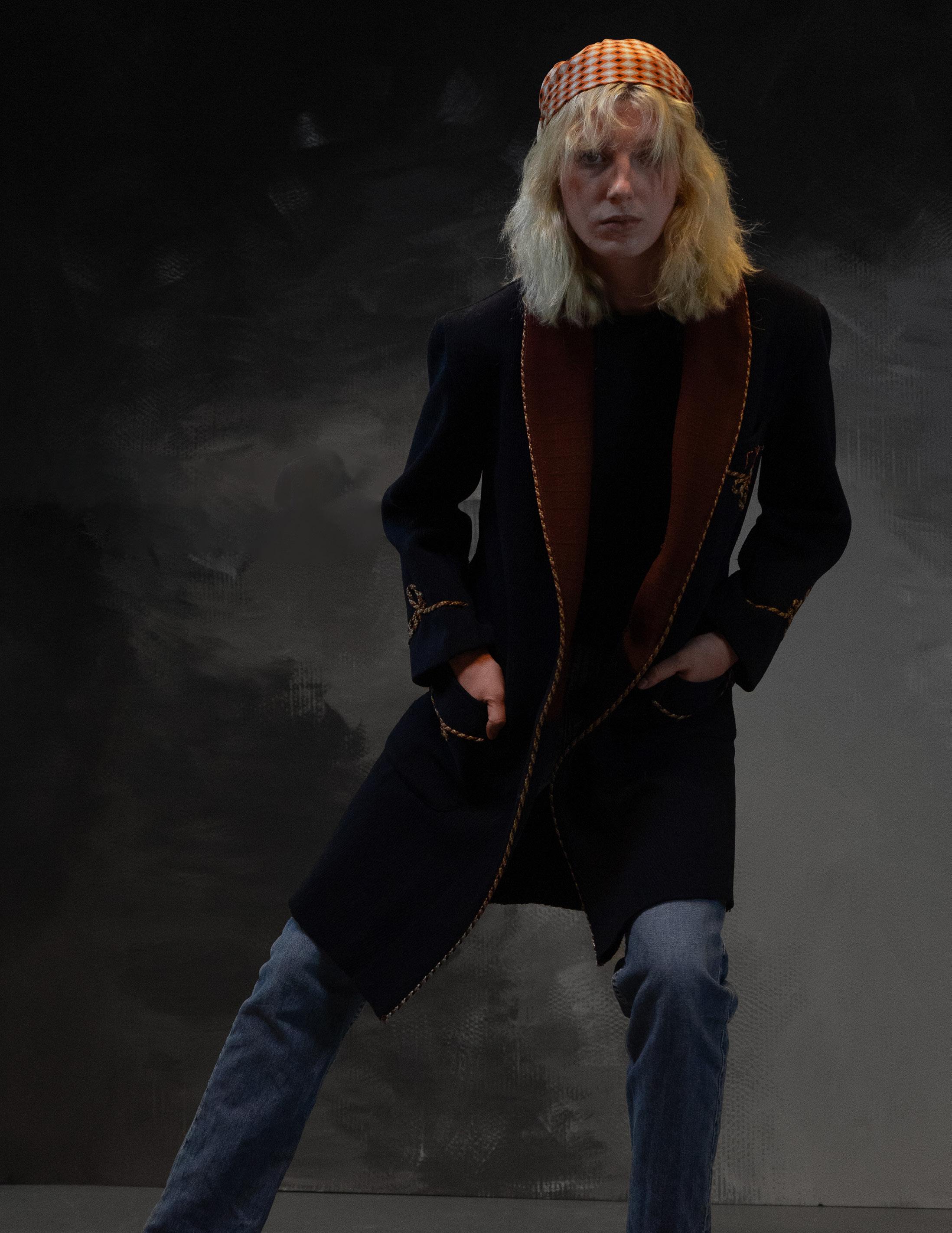


Beading on silk, pearls.
Owned by Sophia Palitti
Gifted to Sophia Palitti by her grandfather, the heirloom and antique has an incredible level of hand beading and shows the savior faire of antique french accessory craft.
Prepare to swoon over this Antique French Purse, an heirloom masterpiece that now graces the arm of Sophia Palitti, a gift from her ever so clearly well fashioned grandfather. This purse is a testament to the French savoir-faire in accessory craftsmanship, with an astonishing display of hand beading on silk that whispers tales of Belle Époque soirées and grand ballrooms echoing with laughter. Pearls adorn its delicate exterior, like drops of moonlight caught on fabric—a true emblem of French elegance and finesse that’s been cherished through generations.

The art of French beading on purses dates back to the 19th and early 20th centuries when Paris was the heart of luxury fashion and artisans pushed the boundaries of intricacy. These beaded wonders were painstakingly crafted, each bead sewn with precision to create floral motifs or geometric patterns that turned each piece into wearable art. The finest examples, like this purse, spoke of opulence and refinement, where even the smallest detail was infused with grace. Sophia’s purse, with its rich embroidery and pearly embellishments, is not just an accessory, it’s a slice of history, a piece that nods to the golden days of French couture where every stitch told a story. Too small to hold much the purse chooses form over function and is simply there to dazzle.
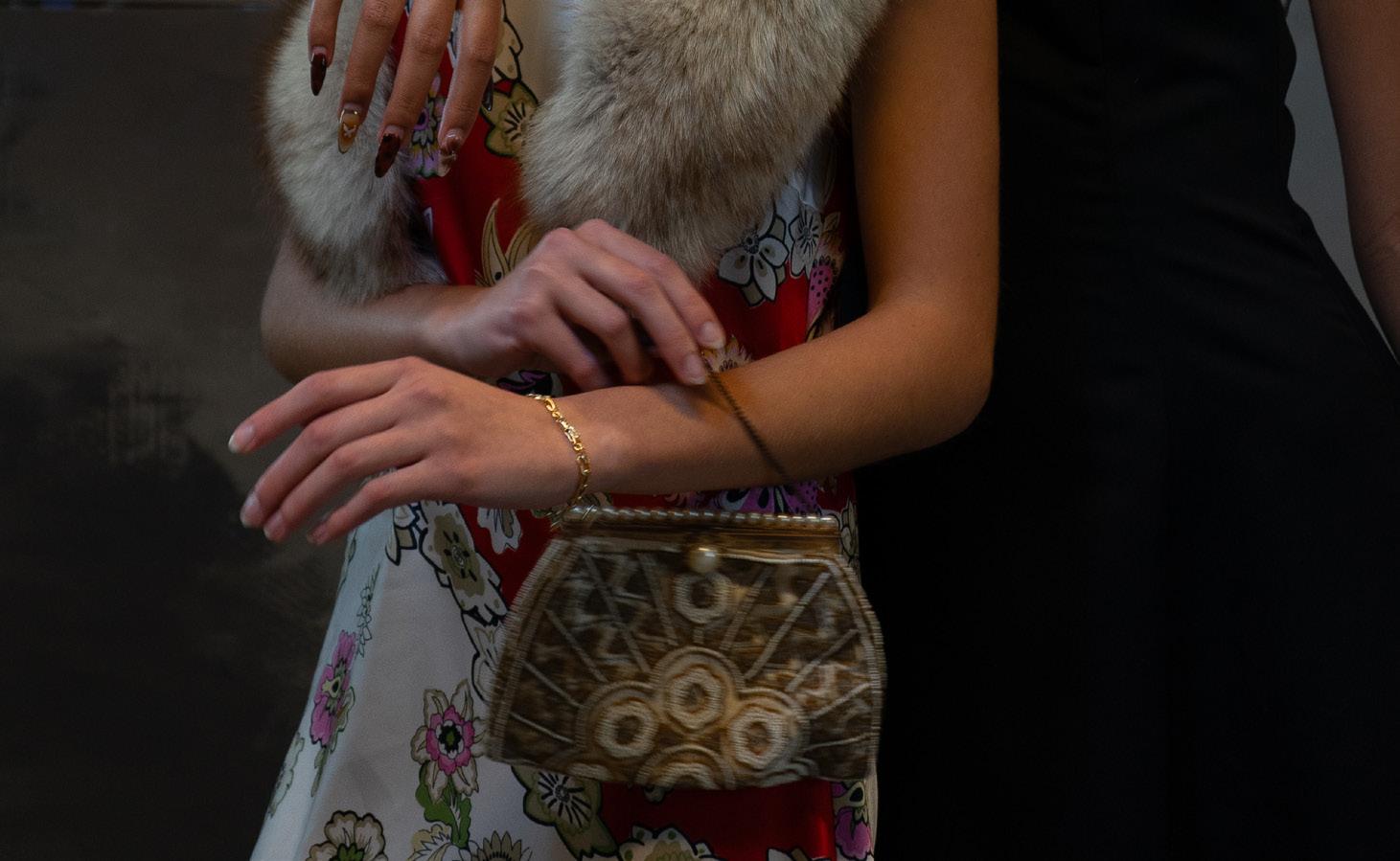
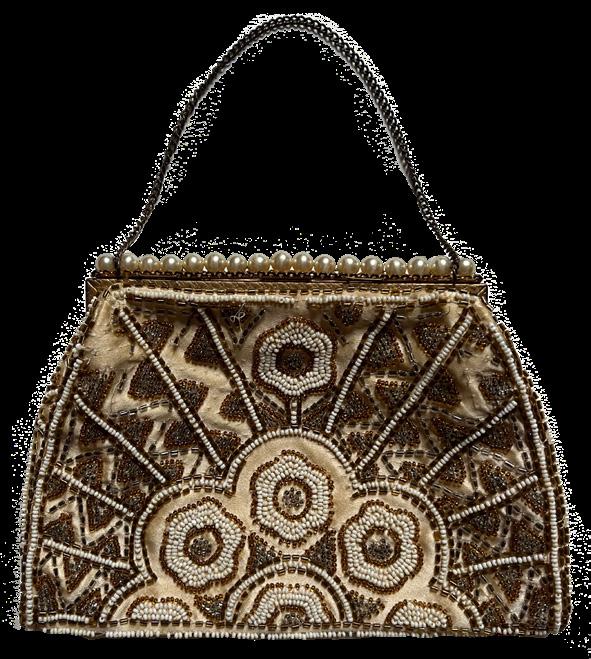

Tweed and white gold.
Owned
by
Reid McVey
This Chanel pin was gifted to Reid McVey by his godfather and became a part of his Chanel costume jewelry collection. The Chanel pin, designed by Karl Lagerfield, represents the camellia flower, an icon of the brand and an everlasting testament to the beauty of the natural world and Coco Chanel's fondness of the flower.

tion with contemporary flair, encapsulating the spirit of haute couture in one delicate, petal-laden marvel.
Step into the shimmering legacy of Chanel with this exquisite camellia flower brooch, a design envisioned by the illustrious Karl Lagerfeld and gifted to Reid McVey by his godfather, nestling among an enviable trove of Chanel costume jewelry. Let’s not forget, the camellia isn’t just any bloom in Chanel’s garden—it’s the bloom. This is the flower that Coco tucked into her lapel, immortalized in everything from haute couture gowns to hair clips that made even breakfast look like a gala, a bloom that captured her fascination for its symmetrical perfection and absence of scent, representing unadorned elegance. In this piece, Lagerfeld’s mastery intertwines tradi-
And what of Chanel’s iconic tweed? A fabric that once dressed the stately shoulders of Scottish hunters until Chanel saw its potential and made it dance through the streets of Paris. Lagerfeld, the grand architect of modern Chanel, understood the magic of such timeless elements and spun them into creations like this brooch. This camellia brooch, born of that tradition, isn’t simply costume jewelry; it’s a sparkling testament to a century’s worth of Chanel’s enduring elegance.



Owned by Reid McVey
Feast your eyes on this Malatesta sarong, a woven tale from the golden age of independent design in 1990s New York. Crafted from printed cotton and adorned with subtle beading, this piece is a nod to the era when the city's fashion scene thrived on eclectic, offbeat designers who dared to stand out amidst the giants. Malatesta was one such name—a hidden gem known to insiders for combining worldly textile traditions with avant-garde flair. Wrapping oneself in this sarong feels like wearing the whispers of fashion week parties where industry mavens swapped secrets and the champagne never seemed to run dry.
Malatesta’s legacy may be shrouded in mystery today, but in the ‘90s, it was synonymous with bold, boundary-pushing designs that resonated with artists. Found in cases at Barney’s The brand’s creations were distinguished by intricate prints that paid homage to far-flung inspirations, from the bohemian markets of Marrakech to the artisan workshops of India. This sarong captures that spirit perfectly—a vibrant symphony of cotton and beaded detail that doesn’t just clothe but tells a story of cross-cultural chic. For anyone wearing it, it’s an invitation to channel the free-spirited energy of ‘90s New York, where fashion was less about trends and more about the story you dared to tell.







Creative Directors
Tirza Elliott, Chandra Phenpimon
Photographers
Omeed Moshifar
Writer




Alexa Djalal
Models
Joy Ani, Aiden Cole, Tirza Elliott, Star Rothkopf, Whitney Short
Layout
John Tischke





Two-by-two bricks, instruction sets, and the little yellow guys that come with it: all pieces that build up Aiden’s heart. Aiden’s lifelong love of LEGO has grown from childhood playtime into a creative outlet that connects his design background with a sense of nostalgia. As a student in the Sam Fox School of Design & Visual Arts, Aiden finds inspiration in the precision and adaptability of its design system, marveling at how each piece fits seamlessly within a broader framework. Whether experimenting with bricks at his studio desk or designing projects like a LEGO-based creativity game, Aiden sees LEGO as more than a hobby; it’s a medium for innovation and connection.
AD Okay, you said that you have been collecting Legos. Please tell me more about that. What kind of Legos?
AC A lot of them are Star Wars. I was a big Star Wars Kid. Some of them are just random.
AD How did you get into it?
AC I played with Legos since I was a kid, and sort of more recently, I’ve rekindled my appreciation for them, just in that they’re really fun. I’m also a design student, and I’m becoming more and more appreciative of the design of Lego and how both it can be used as this tool for growth and creativity as a child, but also it’s just a super well-designed system that’s been around for a while and every single part basically works within the system.
AD How long have you been collecting this?
AC Yeah, I’ve been collecting them for a while. I had a lot as a kid, and I would get the sets, and then just sort of play around with them. Some of them, I would just get a big bag of pieces and see what I can make. But I was definitely more of a set person as a kid. Now I’m sort of moving away, and I’m kind of trying to get more into free building and building without instructions.
AD Like a master builder?
AC Yes, exactly. Actually, I just did a project for one of my classes. I designed this box that had this thing that you pull out, and then all these cards lay flat on the top. And there’s also, like, a little case of Legos inside that also comes up. And then you can take the lid off of the case, and it has instructions for a game. And it has a little spinner. So you put the spinner on top, and then spin it around and land on one of the cards, and one of each of the cards has a little prompt—like “build a creature” or “build a spaceship”, and it comes with a little set of random pieces. It’s supposed to just encourage play and creativity. And it was really fun to make.
AD What did you mean when you said you liked how Legos work as part of a system?
AC I think just sort of the Lego pieces in general, they basically have a few basic connections that work pretty much with almost any Lego piece. And when Lego designers are creating new pieces, they really try to test it with a ton of different interactions with other pieces so that that piece can be used in as many different connections in as many different contexts as possible.
AD So do you like to mix and match your mini figures? How does that relate to how you engage with Legos now?
AC Yeah, this summer I dug in my basement and got all these legos out. A lot of them were already mixed and matched, so it was kind of fun to either reassemble ones that I knew went together, or just make new combinations of pieces to make new characters. So I think that’s kind of another really fun part of it. I also really want to work at Lego.
AD Is there something that triggered you getting back into it?
AC I was in Italy this past semester, which was great. It was through Sam Fox, the Sam Fox Florence program, and we went on a field trip to this International Children’s Book Fair, where a bunch of artists and publishers from all over the world come to Bologna in Italy and they present their artwork. It’s a really, really cool, basically massive convention of artists. There was a booth there that was about Lego books and there was a person who was a Lego designer from the headquarters in Denmark, who was just there for this convention, and she had just a table with maybe 10 different types of pieces. And she was just inviting people to come up and build something with them, and then they could take it. And so I went up and was like, “oooh legos!”. And I checked out this stand and I struck up a conversation with this woman, and it basically just reignited my interest in Legos. She was just really awesome to talk to. I asked her about her career, and I also wanted to sort of learn about what she does as a designer at Lego. I was already kind of leaning more towards product design

and industrial design, and this kind of inspired me to follow that passion more. She gave me her business card and she encouraged me to apply for the internship.
AD Is there a reason that you specialize in, like the mini figures and not like an entire set?
AC I do have entire sets, but the mini figures are just sort of a little more accessible. They usually come with sets but also there’s these little packs of one single mini figure that I’ve collected a lot from throughout the years, and so, a lot of these are probably from the single packs, and two thirds are from actual sets. I mostly just have a bunch of pieces from sets that I’ve deconstructed over the years. I don’t really collect a lot of intact sets, I like to play with the Lego and not just look at a set that I made.
AD What do you do with them? Do they act like room decoration?
AC Yeah, I mean these right now are room decoration, but, recently I basically just took a bunch of pieces that I recently got and dumped them on my studio desk at Sam Fox, and I’ve been either experimenting with things in my free time or procrastinating and building little creatures and stuff. And it was also for the project, which was kind of my excuse for bringing them there. It’s like a fun little thing and sometimes people come by and build something. It’s sort of both something to exercise my creativity but also just something fun to do with other people at Studio. The project that I was talking about, a bunch of people played with it and made their own little things from the prompts—
and it was really, really cool to see. It was fun because my classmates aren’t really Lego people, but it’s still something that you can have fun with and sort of be creative with.
AD That must be so fulfilling. I love that for you. So out of all of your figurines that you collected, which one is your favorite and what’s your favorite thing that you built?
AC I feel like I can’t really pick one that I like the most, but I think the one that’s most important to me is part of this set that’s actually from when my dad had Legos. So this is from 1978 and these are original Mini Figures. It’s like the one that’s in the Lego Movie.
AD Your dad also made Legos?
AC When he was a kid. So it was another random basement find, but I found an unmarked bucket, and I opened it up and there was this set inside, which is just an awesome set. And it’s kind of an important thing. It was just kind of a random toy he had as a kid that ended up being preserved.
AD Why do you continue to do this?
AC There’s a there’s a few factors. I think one, it’s exercising my creativity and sort of bringing a little bit of joy to my life. It’s also a nostalgic thing, I have fond memories of Legos, and it still sort of triggers that same thing inside me. And then, I could say it’s like a procrastination method.

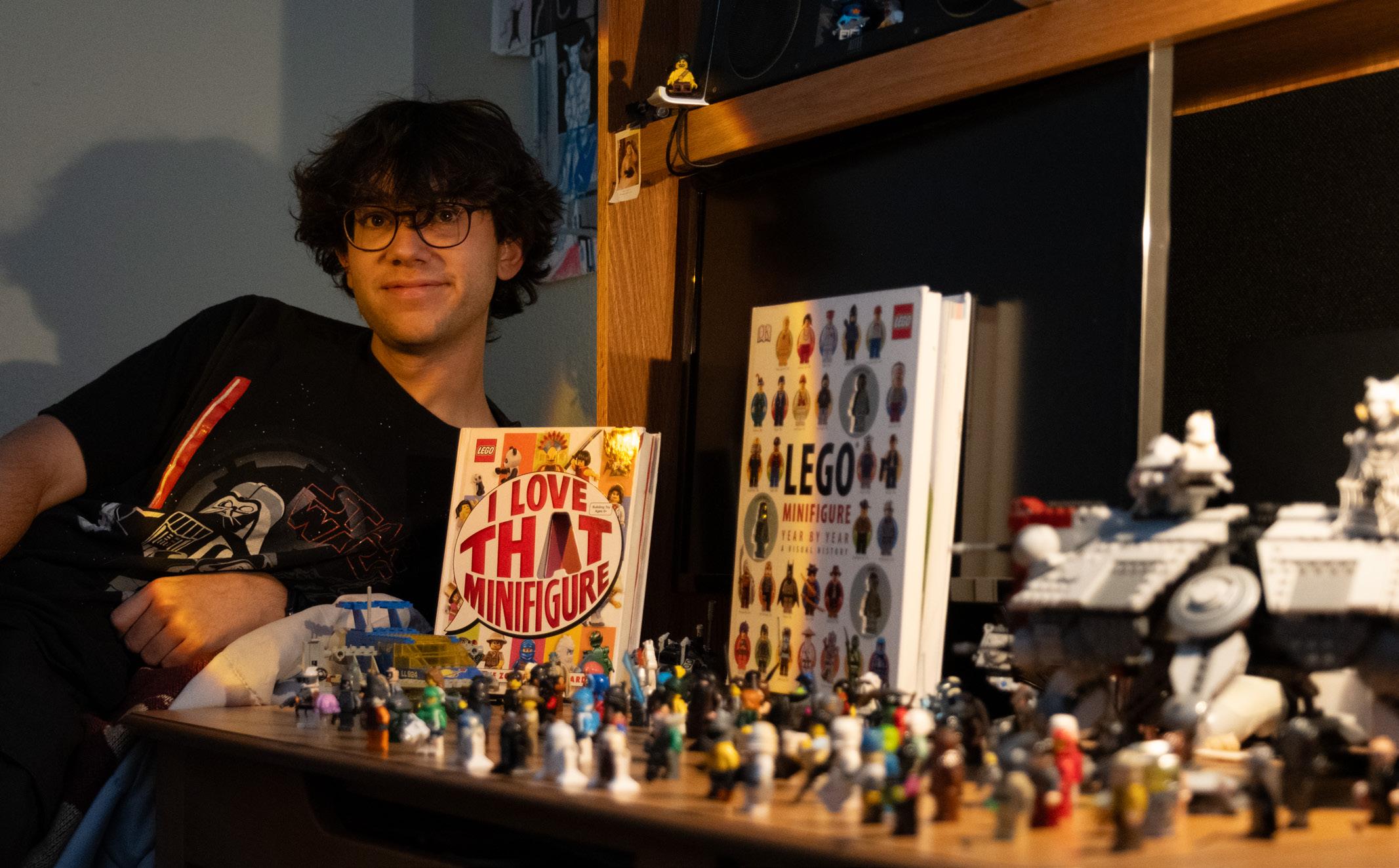

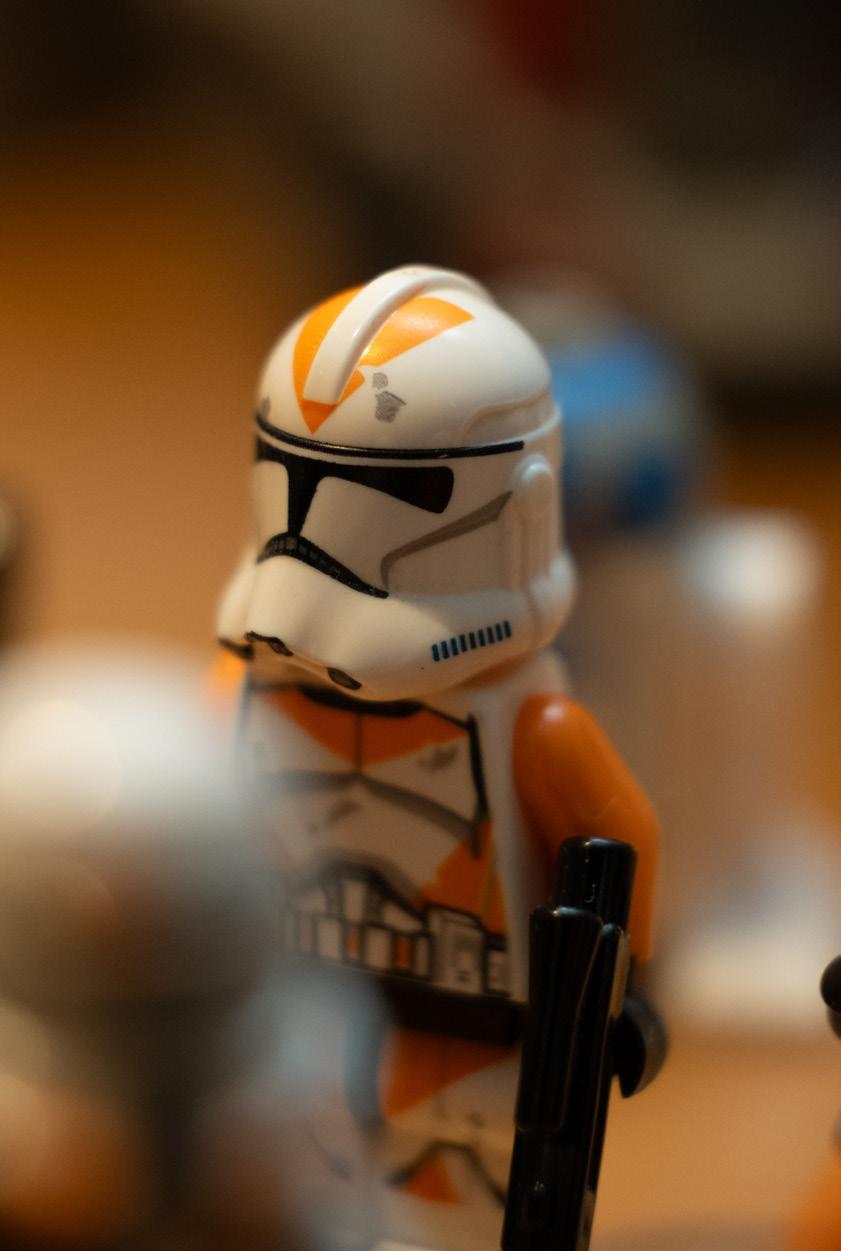


Joy’s love for Littlest Pet Shops and all things miniature is a nostalgic trip back to her childhood. Her fascination isn’t just about collecting tiny figures; it’s about recapturing the innocent joy of her younger years, a world of pastel-colored animals and whimsical bobbleheads. With each figurine, Joy relives memories of her favorite childhood characters and finds comfort in creating small worlds of her own, filled with miniature dogs, horses, and even custom-painted chinchillas. Her collection is a reflection of her love for all things cute, creative, and unashamedly childlike.
AD You said your niche was Littlest Pet Shops?
JA Yeah, Littlest Pet Shops, but also just cute things; small, cute figurines in general.
AD Tell me more about this. What does that mean?
JA When I was younger, I was really into Littlest Pet Shops, My Little Pony, and cute, girly things in general. So I kind of have nostalgia for that. Now I want to collect them if I find them at the store. Recently, Littlest Pet Shop had a revival or a new company started producing the toys again. For a little bit, they weren’t made well, or the art direction wasn’t liked by most of the fandom. Now they’ve reverted back to the original style.
AD You would be collecting toys and figurines, not necessarily posters or other merchandise?
JA Just the little toys, the bobblehead ones. They also have sets, but…
AD What do you do with them? Is it for aesthetic purposes, decoration in your room?
JA Yeah, just aesthetics and decoration.
AD What’s your favorite figurine? Who’s your favorite character?
JA It’s one that I repainted. It’s a dog that I made to look like a character I created when I was younger.
AD Do you have names and stories for them, or is it just for yourself?
JA Its name was Charlotte, but I don’t think I had a story. I just wanted to create a dog with pastel colors.
AD Is there a reason you started collecting?
JA It was easily accessible and nostalgic. They’re only about $3 at Walmart. With the re-release, I got my first set from Five Below for $5, but then I found them at Walmart for $3. They come in blind boxes, so I actually do this thing where I look up the code on the boxes. The first wave was all the same, but the second wave was store-specific, so it’s harder to find.
AD Is there one you particularly want?
JA For the longest time, I was looking for a cow one with little horns that’s brown and really cute. I wanted to gift it to a friend, but I never found it in the multiple times I’ve been to Walmart.
AD Why Littlest Pet Shop? There are lots of childhood shows. Why did this one stick out to you the most?
JA It was one of the first childhood shows I engaged with. It’s made to be collectible, and their marketing worked on me. When I was younger, they had a TV show, but it came later. There was also a community online and it would be funny, because it’d be like people in their rooms, filming their little sketchups, doing dramas or shows. Have you heard of LPS Popular? When I was younger, I would also draw fan art of the LPS popular and also just draw the LPS that I had too. And I even tried to do it myself with the ones that I owned when I was younger with my friend, where we would have a little sketch comedy. And I’m so sad that that happened, but she had a little dog and mouse, and we would call them Penelope. It was just a lot of fun memories associated with that.
AD Is there any character you’re particularly attached to?
JA All the ones I’ve repainted—four of them. One is water-themed, one is lava-themed, another is the dog I was originally talking about, and one is a chinchilla painted to look like ice cream. I’m very attached to those because I customized them myself. At the time, I was just coming up with concepts. I looked up to people in the community who made customs, which got me into it. I thought of opposing concepts like water and lava, and a cute dessert theme for the ice cream one, and turned the dog into the character I had.
AD This has been a long-held passion for you?
JA Yeah, I started customizing in middle school, but I started collecting when I was younger, around late elementary school. I took a break in high school, but now I’m getting back into it in college.


Star is a treasure hunter of silver shiny tidbits and vintage scrolls. Drawn to the sci-fi and tech relics of the 60s, 70s, and 80s, her hobby is fueled by both an academic interest in the history of technology and a personal connection to the golden era of hardware and creativity. Star’s thrift store finds— everything from Atari ads to old magazine spreads—are like little pieces of forgotten futures, each one sparking a fascination with the imaginative optimism of a bygone era. Her collection is as much about connecting with the past as it is about envisioning what comes next.
AD Tell me about your strange addiction!
SR I saw the sign up for this shoot and I feel like I didn’t consciously think I had a collection. Like, I definitely feel like I’m a collector, but I didn’t really realize how I could sort of put that into one collection beyond just like flea market trinkets. I’m from Chicago and all summer one of my favorite things to do is go to any kind of pop ups or local vintage sellers or thrift stores with earbuds, and spend an afternoon going through, you know, stacks of papers and old books looking Rolling Stone or Atari or Isaac Asimov— things for not more than 20 bucks. And then I realized, sort of like, a broader pattern, when I was applying for the shoot that the things that I’m looking for are pretty much exclusively, 60s, 70s, 80s, sci-fi and technology, print media. I am a computer science and English double major. So I’m really interested in the place of technology in society and how it reflects ideology and the ways that it’s evolved with the zeitgeist, I guess, to use an English major word. I think a lot of the current tech era reflects the bland-izing of late stage capitalism and the mindset of something like the old internet or eight bit gaming or physical music hardware was a much more creative and interesting place to be.
AD Was there a reason that you chose the 60s and 70s and not the 90s or 2000s era technology?
SR I mean, that’s sort of like the golden era, or when computing really started to emerge into the popular consumer market. So I guess that’s where things start being available in thrift stores and flea markets. Basically the oldest you can get when it comes to the things that I’m looking for is the 60s.
AD Tell me more about these trinkets. What specifically would you collect?
SR Just like magazines and old advertisements. I have an Atari cartridge– I don’t really have a lot of physical technology. I would love to get more of those old box TVs and stuff. Basically, in books about video games and stuff. This one book I found about video games– I showed it to my dad, and he was like “someone gave that to me for my 10th birthday”. It’s like pong: it goes so far back. I also have ads for music technology, and then a bunch of old sci-fi books. It’s sort of the place where people felt really optimistic about
the potential of technology, and they were imagining all sorts of alternate futures. And that’s where the Sci-Fi comes in. Some really wacky shit that never ended up happening. But I just think that’s a really inspiring and creative mindset.
AD Has it inspired you in any way day to day?
SR I definitely make games. I’m really interested in pro game design, and I definitely bring some of that energy into my own computer science projects and stuff.
AD So you do game design?
SR I dabble. I’m not necessarily that Pro, but it’s definitely an area that I’m interested in. Digital humanities is sort of the overlap of computer science and English. So game design is a part of that.
AD What’s your favorite piece that you have?
SR An original 1980s advertisement for one of the first Atari PCs. I just love seeing how people talked about computers over time— and when these things were brand new, how they were being marketed. Just what people thought of them is so fascinating to me because I guess, sort of in the way that an artist would go study the fundamentals of the ancient artists before them, I feel like modern computer scientists and computing people can learn a lot from going back to these old technologies. But I guess, obviously, there’s a huge danger of romanticizing this time period when it was mostly white men that held a lot of the computing power and currency. But I still think there’s a lot to learn from.
AD Is this something that you share with your parents because they grew up with the same technology?
SR This is very much my dad, my mom is not into any of this stuff. I guess the hippie parents that named me star, you know? My dad is totally a big sci fi lover and tech guy and Dungeons and Dragons kid. It was totally one of the ways that I connected with him. I used to have a VHS tape of one of my favorite old sci fi animated movies. It’s called Fantastic Planet. But I don’t have it anymore because I gave it to my friend who has a VHS player, because I don’t have one. You know, she should be able to have it and play it. I kind of miss that a little bit.

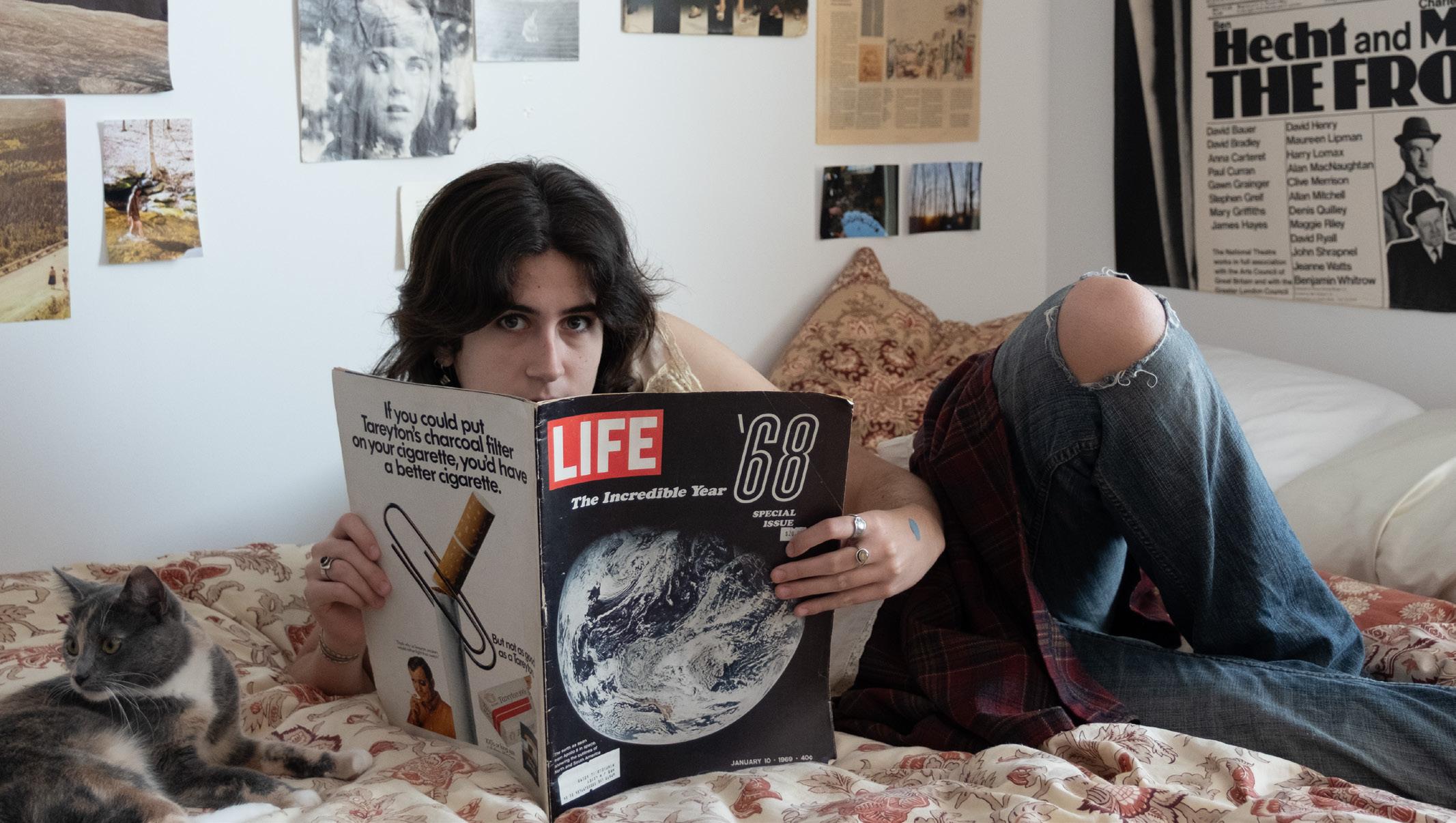


AD What’s the process of picking things out? Are you like going off of aesthetic purposes, or, like, the content?
SR Definitely a mix of both. Because there is absolutely just a straight aesthetic element. I really love all of these old fonts and color schemes and the texture of the paper—they’re just beautiful artifacts in themselves. But then what they stand for is super fascinating to me. Another thing that I really like that I have on my wall is this photo: Earth rise. It’s like one of the first photos from the moon. That’s from this Life 1968 magazine. And it was the original publication of this photo that basically started the environmental movement, because people could see the earth from space and it gave them a totally new idea of unity as a species and the need to take care of the planet and it just like defamiliarizes you from your normal experience on Earth, compared to seeing it from the moon. I just love that it has that effect– and science fiction does in general. As an English major, we talk about science fiction from the lens of it being able to defamiliarize you from your current state of life by talking about aliens and robots and corny stuff like that. So that way you can see your norms and your life and society for what it is from a new lens.
AD Is there a time where something like that brought you unexpected joy?
SR I guess I wasn’t even intentionally trying to develop this kind of collection or that I was searching for this specific 1980s Atari advertisement. It would just be the kind of thing where I would be in San Francisco with a friend, and we would go thrifting, and then we would come upon this. I’d be like, “Oh my God, this is so cool”. Like, how is this just sitting here, you know? And then it just makes you think about time and how the things that are modern now,
someone will probably find in a thrift store. And things are so cool later. So I guess all of these, I’m like, holy crap. I can’t believe this is here. Please give this to me!
AD Is this something like you want to keep doing in the future?
SR Definitely. I just love the idea of treasure hunting. And I guess a lot of amorites can probably relate to the sense of excitement while thrifting and finding cool and unique pieces. I guess that’s just how I feel about the collection as a whole.
AD You think like, because, like, you’re interested in the technology aspect, as like, time goes on, you’re gonna switch eras,
SR Lowkey, no, because there’s really like this one origin point where there was just this boom in computing power, and I guess at some point in the future, we’re gonna have to make another jump from Atari to MacBook, from MacBook to, I don’t know, some other thing, some other completely different,unimaginable kind of technology, like quantum computing or something
AD Do you remember the first thing that you got? I was like, Oh my gosh, wow.
SR I feel like I couldn’t even point to the first thing that I found. But I guess it was probably the Atari advertisement where I was like, “Wait, this is actually cool”. Maybe I should try to find more things related to this because it’s such a distinct artifact



Tirza is the undisputed Heaven queen, draped in the kaleidoscopic, Y2K-infused artistry of Marc Jacobs’ boldest fashion experiment. To her, Heaven isn’t just clothing—it’s wearable art, a vibrant defiance against the monotony of the everyday. From sweaters stitched with celestial patterns to purses emblazoned with the brand’s signature double-headed bear, each piece is a carefully chosen relic from limited drops, a fleeting moment of fashion history that she alone has claimed. With a collector’s patience and an artist’s eye, Tirza curates a wardrobe that’s both nostalgic and futuristic, a little rebellious, and entirely her own.
AD You said your passion was Heaven by Marc Jacobs. Can you tell me more about that?
TX Well, Heaven is a brand. They make clothes like jewelry, purses, and I collect all of it—even hair accessories. Why I collect it? I feel like, I don’t know, it’s just cool. Like their clothing pieces are cool.
AD Is there a certain theme Heaven is about?
TX It kind of gives almost Y2K, but also art. I feel like each piece is like a piece of art in and of itself... So it’s like wearing art in a way and that’s what I like about it.
AD Do you wear this in public or is this just aesthetic?
TX I wear Heaven. My main school bag is a Heaven bag. The bag is just black, but I like to put keychains on it and their little thing is like this double headed bear logo.
AD And you would decorate it? Like I see the key chains and everything.
TX Yes! The key chain to add. And its Heaven too.
AD Do you personalize all your stuff?
TX Not really. I also have another purse with the same little bear– sometimes, I put the key chains on it, but I feel like it’s already art in and of itself. And then the clothes, like the sweaters and the shirts, it’s an easy statement piece for an outfit.
AD How much do you have?
TX I guess like 20 pieces. Like a handful, I guess.
AD This is a pretty expensive hobby right? How does that fit into your budget?
TX Well, I’ve collected over time. I think they were launched in 2020 and since then, I’ve gotten stuff for things like my birthday or a little splurge gift or things they have
a specific drop on. Once something is sold out, it’s gone, it’s in their archive. So I feel like when I know there’s a heaven drop coming, I’ll like wait and l see and be ready for it.
AD How do you go about like finding which pieces to get? Is there a certain aesthetic that you’re looking for?
TX I feel like heaven overall is its own aesthetic. So anything that they drop, for example their earlier stuff was all consistently Y2K colorful, cool patterns or cool textures. I really like their sweaters because they’re this cool knit pattern— and I have two of them that have stars on them. Heaven just feels like childhood, girly pop, and a good mix of adulthood.
AD You said before that you chose heaven because of like the aesthetic purposes, right? But I know Marc Jacobs has a lot of other collections. Is there a reason that you chose heaven specifically? How do you feel like it connects to you?
TX I like that Heaven specifically is super unique. It’s not like the rest of the stuff that Marc Jacobs makes. It’s very specific and niche in piece of clothing or purse or accessory. There’s not another one like it. If you bought it from that drop, it’s the only one like that.
AD Do you feel like that’s something that resonates with your personality?
TX Yes, I’m someone who doesn’t like to do things other people are doing. That’s something I like that’s rare. I feel like there’s a lack of color in the world. Heaven is very colorful and it gives a sense of joy. I’ve been called the Heaven queen. People know I’m associated with this.


Whitney is a collector of tiny, wide-eyed companions—Sonny Angels, ceramic cherubs, and the occasional antique baby doll that carries a century’s worth of stories. What started as a single, surprise-box purchase has grown into a quiet, whimsical presence in her life. A Sonny Angel perches on her laptop, another rides in her pocket, and a tiny army dangles from her car’s rearview mirror, serving as both decoration and, in her mind, self-sacrificing guardians. To Whitney, these babies are funny, a little eerie, and oddly comforting—whether watching over her home, accompanying her through the day, or forever stationed in a Minnesota research lab as a tiny reminder of her presence.
AD You collect Sonny angels, right? Can you tell me more about that?
WS Sonny angels, but also lowkey a lot of baby dolls. I was a Sonny Angel for Halloween last year. I find I like to carry one around with me so I’m not alone. I have three ceramic babies on my wall. I have a hundred-year-old baby doll passed down to me from my great aunt. The Sonnys say He may bring you happiness? And he’s right.
AD How did you get into it?
WS I just kind of think they’re cute. My roommate Lizzie originally showed me the babies and I bought one, and then they’re just—they’re just so cute. When you buy one, it’s a surprise of what it’s going to be. And so I kind of just have a bunch of them. I really like them. I have one on my computer. I often take one around with me. It’s there throughout my house and my bedroom. I also inadvertently have a lot of other babies. See on my wall right there?
AD Why babies? What’s going on with babies?
WS I don’t know. I just think it’s kind of funny. It is funny. I love it. It sounds creepy when I write it down but it’s really random. And I like that. I think they’re funny to have. And then I have in my car you know those little, plastic, tiny baby things that are the size of your thumb, like on a keychain. They’re just small little babies for crafting, I think is their purpose. And I have a chain of them in my car that’s over the rear view mirror. And, one time, I almost got into a car accident, and two of them fell off that day, and I was like “oh, like, they’re my guardian angels”. So now I tell myself that, like the ones in the car, my guardians, they’ll sacrifice themselves for me if I was gonna get in an accident. Anytime one falls, I know that it saved my life. And then I have a sonny Angel costume that I wore for last Halloween.
AD So what is a Sonny Angel exactly? Is it a figurine that was made for collection purposes?
WS I’m pretty sure it’s a little baby figurine. They’re made for collection as little toys, because they’re kind of like a surprise box. You just don’t know what. Like in an animal series, you don’t know which animal it will be. And so people collect them.
AD When did you first start collecting them?
WS Maybe a year ago.
AD What’s your favorite baby you have, besides the car ones?
WS No, I don’t really think about those ones. The sonny angels are my favorite. I had an Apple one on my Apple computer for a long time, and that one was great.
AD Is there one you have a specific emotional connection to or a cool story with?
WS So this summer, I did research in Minnesota with a lab, and I left behind a sonny angel in the lab. I attached it to the top of the conference room TV so that they’ll always remember me, and I told them that my spirit is in it.
AD Ah, wait, I love that you attach yourself to some of these. These are so cute. How do your friends feel about them?
WS Most of them like it. One of my roommates collects them too. Some of my friends think they’re weird because they have genitalia. They all have little penises.
AD Is there a specific reason that you’re still invested in it?
WS I just want to get more. I want the other hats that they wear. I want the different collections and they have limited edition ones. I’m just a consumer, unfortunately.

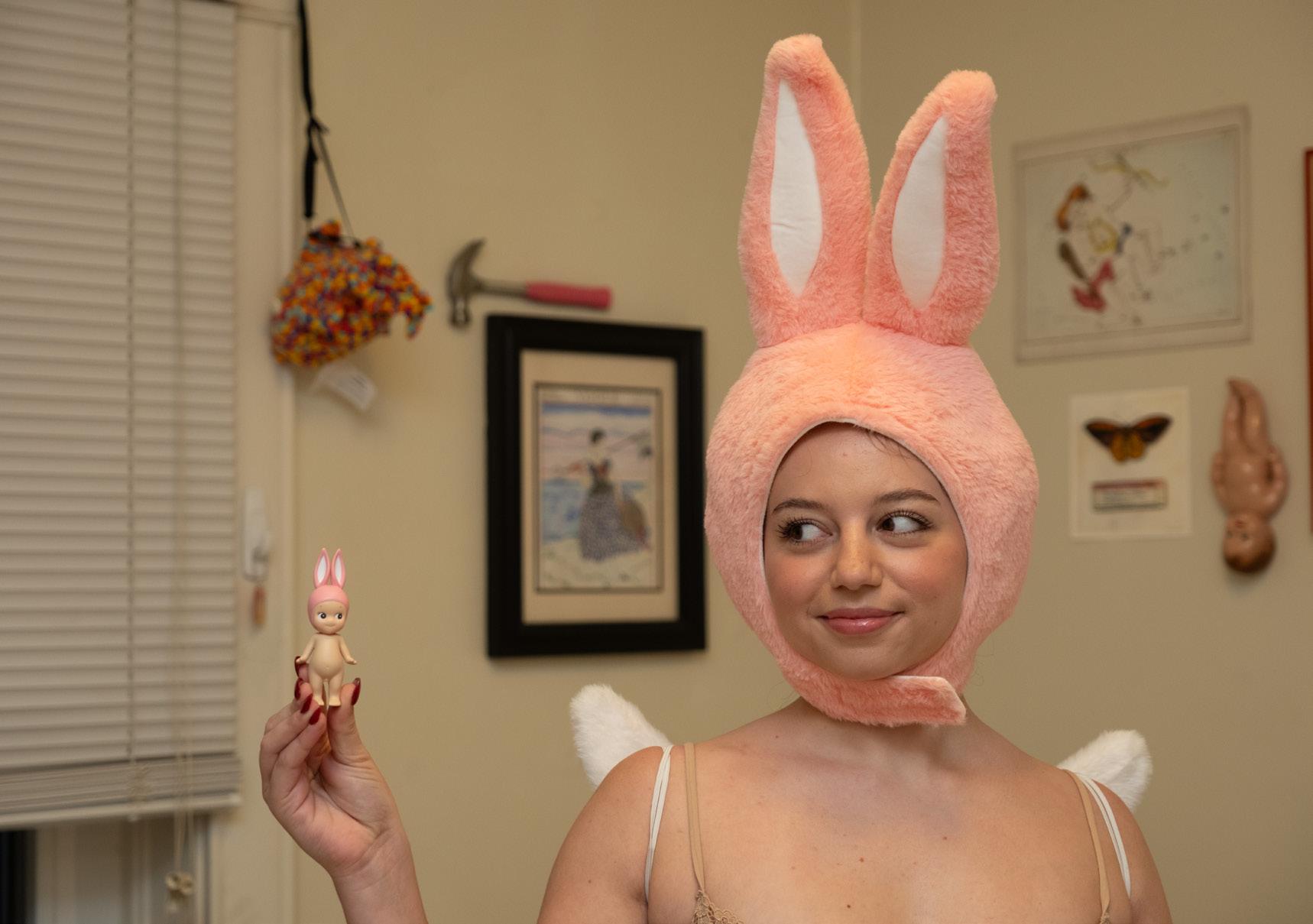




Creative Direction
Evelyn Pae + Seo Eun Kim
Writing Josie Blough
Photography
Andy Li + Sofia Huitron
Modeling
Fiona Lyons-Carlson + Judy Li
Layout Design
Fiona Lyons-Carlson
Styling
Violet Holah + Seo-Eun Kim + Evelyn Pae
AIn a crowded room, Cold eyes surveille from every angle. A bitter chill diffuses into the space, sinking through my skin and through the fibers of my clothes Drilling deep into every pore, Making home within me. They pierce the air I inhabit, with such potency it becomes audible, puncturing my air bags, A feeble, dying whine. A forced out slow, staggered breathing. I could say anything, words could unfurl out of my mouth, rolling off of my tongue in an incantation, a lost language.


awaydrains still watch. I could speak in any dialect, and they would still watch. watch.tch. hours tch.

hours

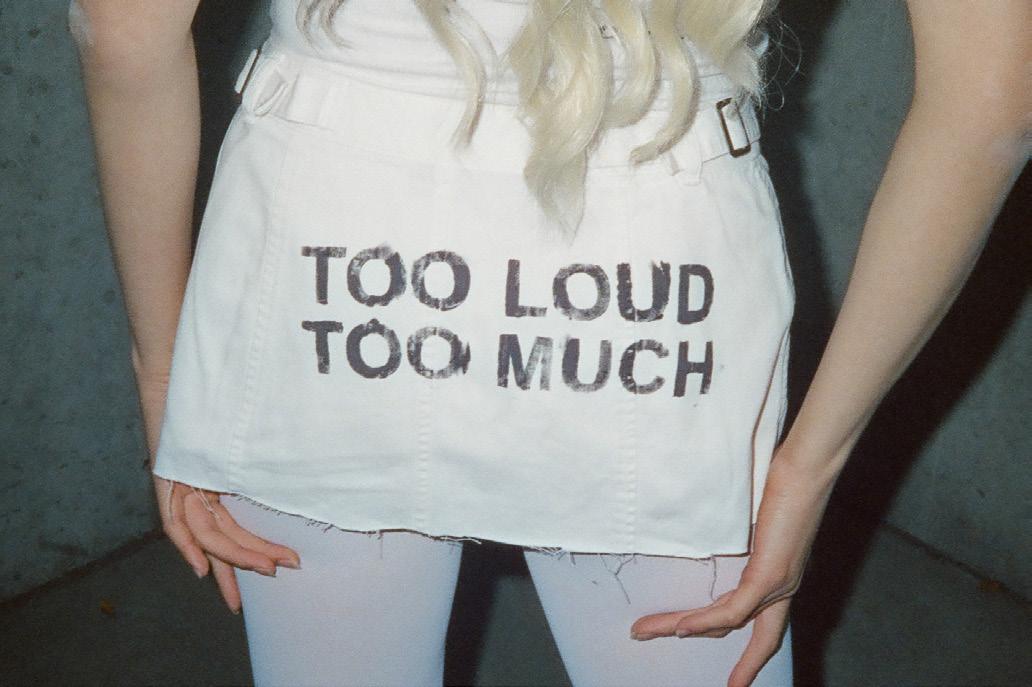
It would slip my mind what was even said. I could speak in any dialect, and they would still watch.
I feel them even when I am alone, in the darkened hours when sunlight drains away, a slow siphon of pigment from the sky, leaving the both of us cold and pallid.
They follow me in the corners of my room, a steel drum pounding sound hollowing out my brain, circadian rhythm disrupted. Cold eyes will never warm, will never become sweet or soft or safe.
I could say anything, do anything, be anything, and they would still drill deep down, burning ice cold blisters deep, deep within.
In the darkened corridors of the brain
a record glitches, the lyrics repeating themselves, a haunting lullaby.
In an interminable loop, a lone dancer spins I feel her drilling into my head, her ballet slipper soiled crimson at the toe Broken, blistered, bruised
A chilling mind body connection made manifest
She spins alongside the broken record, feet bound to the floor.
In a scarlet serenade, She is a distant deity an illusionary idol
An invader taking shelter in the tunnels of my mind
I want her out, yet she is showcased on my stage, On display, a caged animal.

Her hair glows, a fiery red thing. Enveloped in the cool, cool light, She spins and spins as the song fizzles out The record popping and cracking in a cacophonous meter
She knows the song is on a loop
She knows I am exhausted from her dance
She knows I want quiet, quiet, quiet
She knows I see the vermillion spot
That she has left beneath her feet on the linoleum floor

She knows I want the record off and the curtains to close She knows, yet she remains poised, perfect, and relentless.
She lives within me, Making herself welcome in a private space. From now on I guess I will have to save her a seat.
Jared Garelick and Liora Raimondi
Liora Raimondi
Ethan Crandall, Jenna Nguyen, Aneesah RiveraNichols, Claire Ackley, Tatum Goforth
Tyler Hanson Manthur
Smith
Sophia Palitti and Maeve Collins
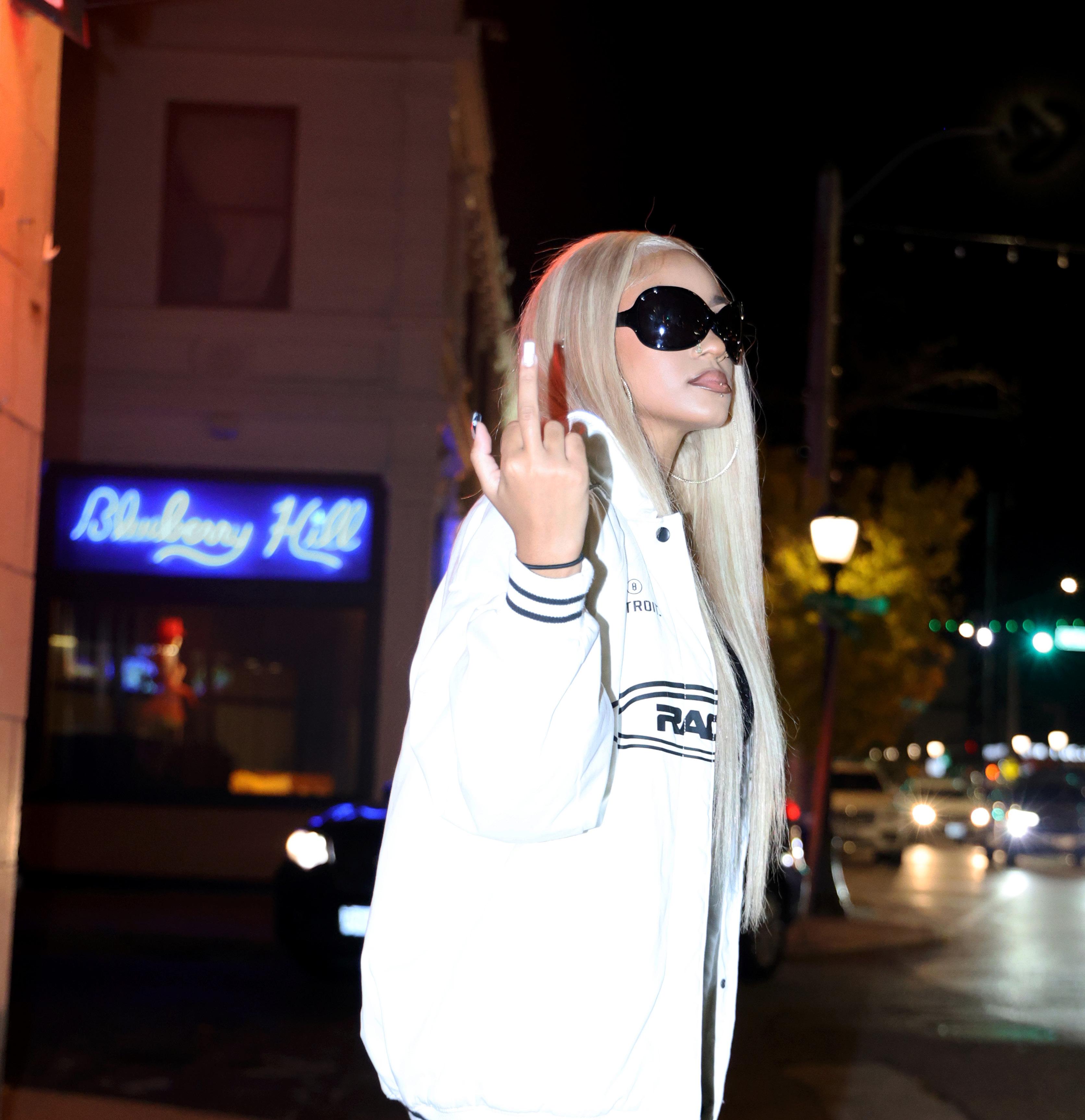

vy’s taste in food has been a center of con troversy for her, ever since she went on an unprovoked Instagram rant a few months ago shaming people for “only eating trash” and “not thinking about what’s best for their body.” Little did her followers know, but Ivy indulges in some of the most strange eating habits our researchers have ever seen.
Ivy Knox, the notorious self-proclaimed wellness guru, has found herself in the middle of a food scandal after paparazzi caught her shopping at the local Schnucks grocery store — and let’s just say, the contents of her cart raised eyebrows.
Known for her rigorous diet and controversial health tips, Ivy was snapped loading up on an unusual assortment of items: dog food (she doesn’t own a dog), baby food, and enough cookie dough to feed an army. This bizarre combination has left fans scratching their heads and wondering why she would possibly need these items, especially considering Ivy’s very public — and rather judgmental — stance on “eating clean” and “living your best, healthiest life.”

one fan tweeted. Another posted, “I guess she wasn’t talking about organic baby food… Who knew that was part of her ‘clean eating’ routine?!”
Just a few months ago, Ivy made headlines after an infamous Instagram rant where she told her followers, “If you’re still eating trash, you’re literally poisoning your body. Start thinking about what you put in your system. We’re not meant to live off processed junk.” She went so far as to call out everyone, from fast-food lovers to those who simply “couldn’t be bothered to eat organic.” Ivy’s fans, many of whom look to her for dietary advice and lifestyle inspiration, were then left stunned by the questionable food choices Ivy was secretly indulging in herself.
“Honestly, I can’t even believe this. Ivy has been telling people to avoid sugar, dairy, and anything ‘unnatural’ — and then she’s out here buying dog food?!”
So what exactly was Ivy picking up at the store? Among her alarming purchases, sources confirm she was seen loading up on cans of Pedigree dog food — yes, you read that right — and jars of organic baby food purees, with flavors ranging from squash to sweet potatoes. But what really tipped the scales into “WTF” territory was the refrigerated cookie dough she grabbed. We at Celeb Nat Geo love a good Toll House dough, but not in such quantities! Multiple sources say that the actress was seen tossing several family- sized? packages of the indulgent dough into her cart, clearly ready to indulge in a sweet treat or two (or ten).
We reached out to Ivy , who declined to comment, only raising our suspicions more.We looked to our devoted readers to weigh in on what could possibly be



old on to your hats, folks — because Vivian Shaw has gone through more transformations in the past month than most celebrities do in a lifetime! The pre-med sophomore, known for her wholesome, family-friendly persona, has shocked fans by completely flipping her public image on its head. And it’s all happened in record time: one month.
At the beginning of October, Vivian was the epitome of a "good girl" — a student with a squeaky-clean track record? adored by many for her charitable work and commitment to promoting kindness and mental health awareness. She was the face of the popular service fraternity of APO. But just a few weeks later, Vivian found herself at the center of a media frenzy after a series of shocking events left fans questioning everything they thought they knew about her.
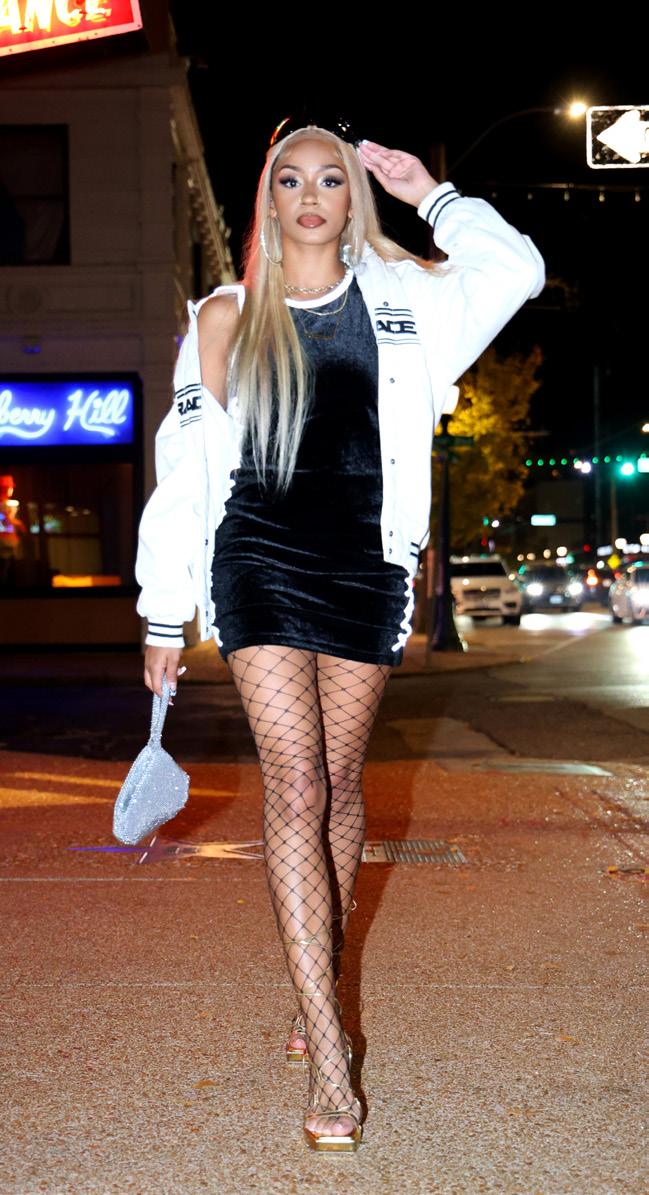

“Did she just go from party girl to cult freak in a matter of days?” one confused fan commented on her post. Another wrote, “Vivian, what are you doing? You can’t just switch from one extreme to the other like that.”
Sources close to the actress say that this “spiritual awakening” came after a tumultuous few weeks, but exactly what caused the sudden shift remains unclear. Some insiders claim that Vivian has been struggling with the pressures of academics and others suggest she might have been influenced by a new romantic partner — one who is reportedly very religious and encouraged her to explore faith.
It’s safe to say Vivian’s dramatic transformation has left her fanbase divided. Some are supportive, saying that everyone has the right to change and evolve, while others are wondering if this is all just one big PR stunt. “I just want the old Vivian back,” one fan tweeted. “The one who didn’t go from partying to preaching overnight.”
In the meantime, Vivian seems committed to her newfound faith, but whether this latest phase will last is anyone’s guess. One thing’s for sure: with her ever-changing public persona, Vivian Shaw is keeping us all on the edge of our seats.


hat happened to Piper Blackwell? The fashion design major and self-proclaimed sustainable fashion icon, known for her quirky “thrifted treasures” and “zero waste” lifestyle, was caught by paparazzi this week in an outfit that can only be described as a fashion disaster of the highest order. And this time, it wasn’t just a one-off—Piper has been on a full-blown style streak that has left her fans and classmates seriously concerned about her sartorial choices.
It all went down outside a trendy café, where Piper was photographed strutting down the street with what could only be described as a total trainwreck of an outfit. That fateful sunny afternoon, Piper was seen wearing the following mismatched ensemble: a neon colored paisley skirt (which we’re fairly certain came from the depths of an ‘80s thrift store bin), over a pair of bleachstained jeans,, ill-fitted denim vest and a red furry scarf. But what really set the fashion world on fire? The toilet paper. Yes, you heard that right—toilet paper.
As the paparazzi snapped photos, Piper was seen with a noticeable strip of toilet paper stuck to the bottom of her two-sizes-too-small red heels. And it wasn’t just one square. It looked like a full-blown roll had decided to take a detour and attach itself to her foot. Some say it was an unfortunate accident, while others are speculating that it might have been a weird “statement” on consumerism—because, you know, Piper’s all about using what’s “already available.”
For those who don’t know, Piper has long touted herself as the “queen of thrift,” a champion of sustainable fashion, and an advocate for “recycling” old clothes to create one-of-a-kind looks. She’s built an entire brand around the idea that thrifting is the future, and has spent years shaming those who shop fast fashion. “True style is about finding treasures in places others overlook,” she said in a previous Celeb Nat Geo interview. “It’s about being artsy and original—not just following trends.”
However, this recent outfit was anything but “artsy.” The skirt, which seemed to be a poorly executed attempt at mixing prints, was so unflattering that it practically screamed “DIY disaster.” But the toilet paper? That was just the cherry on top of a very questionable sundae.
Fans and fashion critics alike were quick to comment on the strange series of outfits that Piper’s been sporting lately. One fan commented, “Piper used to be such a style icon… but what’s happening here? First the ill-fitting skirts, now toilet paper on the shoe? This isn’t the sustainable fashion queen we know.” Another wrote, “I get the whole ‘thrifted’ vibe, but girl, this is beyond thrifty. At this point, it’s like she’s trolling us. I just am so disappointed in her and can’t imagine supporting her after this.”
Even her classmates, who’ve known her for years, have started to question their loyalty? “Piper used to be effortlessly cool,” one of her old friends shared with us in an exclusive interview. “But now? It’s like she’s trying too hard to prove she’s artsy or ‘ahead of the curve,’ but it just looks… well, terrible. Honestly, I’m kind of worried she’s lost her sense of self. That skirt? It’s like she’s giving up on life.”
The toilet paper incident isn’t the first time Piper’s been spotted in controversial attire. Over the past few weeks, she’s been photographed wearing an assortment of strange pieces—like mismatched shoes, a stained denim jacket, and, at one point, a dress made entirely of old fabric scraps that seemed to be falling apart in real-time. It’s as though she’s trying to create a look that screams “intentionally ugly” but is actually just… ugly.
Despite the criticism, Piper seems unfazed, doubling down on her commitment to “creative expression through fashion.” In a post she shared earlier this week, she wrote: “Fashion is about individuality. I don’t follow trends. I create them. And sustainability is about reimagining what we already have. Every piece of clothing has a story, and I’m telling mine.”
But the question on everyone’s mind is: is this really artsy? Or has Piper truly lost her fashion touch?
One thing’s for sure: with each new outfit, Piper is pushing the limits of “thrifted chic” in ways we never thought possible. Will she ever return to her former style glory? Or has Piper Blackwell truly gone off the deep end, trading in high fashion for high confusion? Only time will tell—but for now, it seems the only treasure Piper’s found is the toilet paper stuck to her shoe.
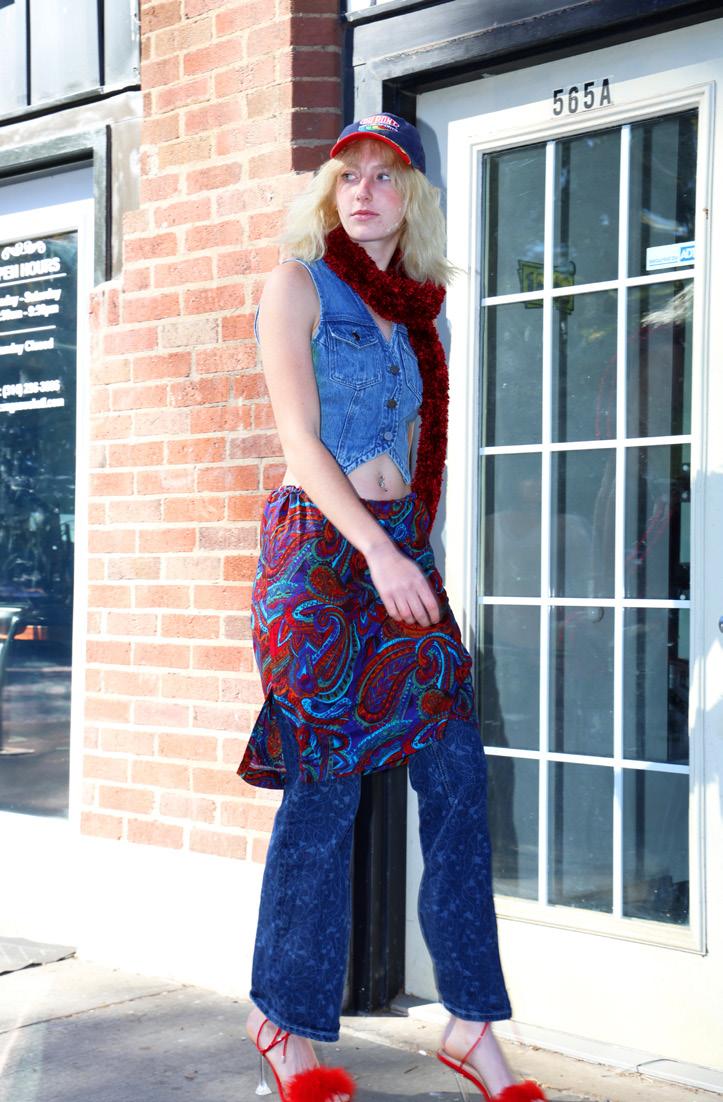



he Olin Diva, Milan Moore, is stirring up noise once again—but this time it's not for being blacklisted from another frat. The marketing major was spotted by our journalists leaving Dr. Stefano’s clinic earlier this week, sporting a noticeably different nose. It seems Milan has, once again, gotten a nose job. That must be her third nose in the past two years!
“Milan is just really committed to self-improvement—both academically and aesthetically,” a friend and confidante of the campus icon revealed in an exclusive interview with Celeb Nat Geo. “She’s been experimenting with some life changes. This nose job was just part of her journey. It’s not like she didn’t love her old nose, but as a marketing major she understands the need to curate her evolving brand. The nose needs to match”
This latest nose comes just a few months after Milan was caught with a new side profile last July. Then, her new miraculously button-like nose was attributed to an all organic and locally grown diet. Some fans are beginning to question just how much work is too much. "She looked stunning before," one Sidechat user posted. "Now it’s like every time she gets a new procedure, she looks less like herself. Is she trying to keep up with the Instagram filters?"
When we reached out to Milan to comment, she
Marketing major. Olin icon. Milan is no stranger to plastic surgery, despite preaching “be yourself” on her mid-size Instagram influencer account.
claimed:“I had to get the surgery for medical reasons. I have a terribly deviated septum.” But readers, note that was the claim she made after each of the last two nose jobs. How many deviated septums can one really get? Perhaps we should beware of the apparent “deviated septum virus” or we may find ourselves requiring a little extra help from the surgeon’s office. Stay tuned—something tells us this isn’t the last we’ll hear about Milan Moore’s evolving beauty regi-








t looks like Theo Harrington, social media’s eco-ac tivist darling, might not be as “green” as he wants to seem. The senior and environmental crusader, known for his impassioned speeches about sustainability and overconsumption, was caught red-handed by paparazzi this week — at a local gas station… pumping diesel into his car.
The stunning revelation comes just days after Harrington was interviewed by Studlife,discussing the importance of reducing carbon footprints, promoting plantbased diets, and curbing the use of single-use plastics. This moment was meant to bolster his image as the university’s leading voice for environmental activism? But now, it seems that Theo’s commitment to the cause may not be genuine after all.
While wearing a real fur coat, Theo was seen fueling up his diesel-powered vehicle in broad daylight, much to the shock of Nat Geo Celebs photographers lurking nearby. “He was so focused on pumping gas, he didn’t even notice us snapping pics, until I got too close, and he reacted? like a douche” one photographer shared. “It was a little awkward, honestly — given how outspoken he has been about fossil fuel consumption.”
The irony doesn’t end there! Our researchers were up through the night digging, and sources revealed that the eco-activist comes from old money,. is father, billionaire oil tycoon Charles Harrington, controls one of the largest oil conglomerates in the world. “His father is responsible for a significant amount of carbon emissions,” an insider commented. “There’s certainly no denying the privileges and lifestyle that come with it. Theo may speak out about big oil, but the Harringtons are literally profiting from it.”
Fans are taking to social media in droves, questioning Theo’s credibility. “I get it, we all have our contradictions. But come on, preaching about climate change while pumping diesel into a car that probably costs more than most people’s houses? Not a good look, Theo,” one user posted. Another commenter joked, “When you talk the talk but your car walks the oil-soaked walk.”
Theo’s PR team has been working overtime to limit the damage, and sources say that an official statement is coming soon. But the question remains: how much of Theo Harrington’s “green” activism is genuinely about saving the planet, and how much is just part of a carefully curated image?
Keep your eyes peeled for updates, because this is a green scandal that’s sure to leave a bad taste in your mouth.


CREATURES OF THE NIGHT DRIPPING IN LEATHER AND CHROME ACCOUTERMENTS. KNIGHTS IN SHINING ARMOR OFFER PROTECTION FROM THE DANK, DRY, BUTTONEDUP DAY.

STAFF
CREATIVE DIRECTORS
Jose Villacana Brugada, Aiden Cole, Noah Kim
PHOTOGRAPHER
Ryan Kim
WRITER
Seth Skiles
MODELS
Fiona Lyons-Carlson, Teddy
STYLISTS
Jose Villacana Brugada, Aiden Cole, Noah Kim
MAKEUP ARTIST
Oliva Slemmer
MODELS
Teddy Lee, Fiona Lyons-Carlson
LAYOUT
John Tischke



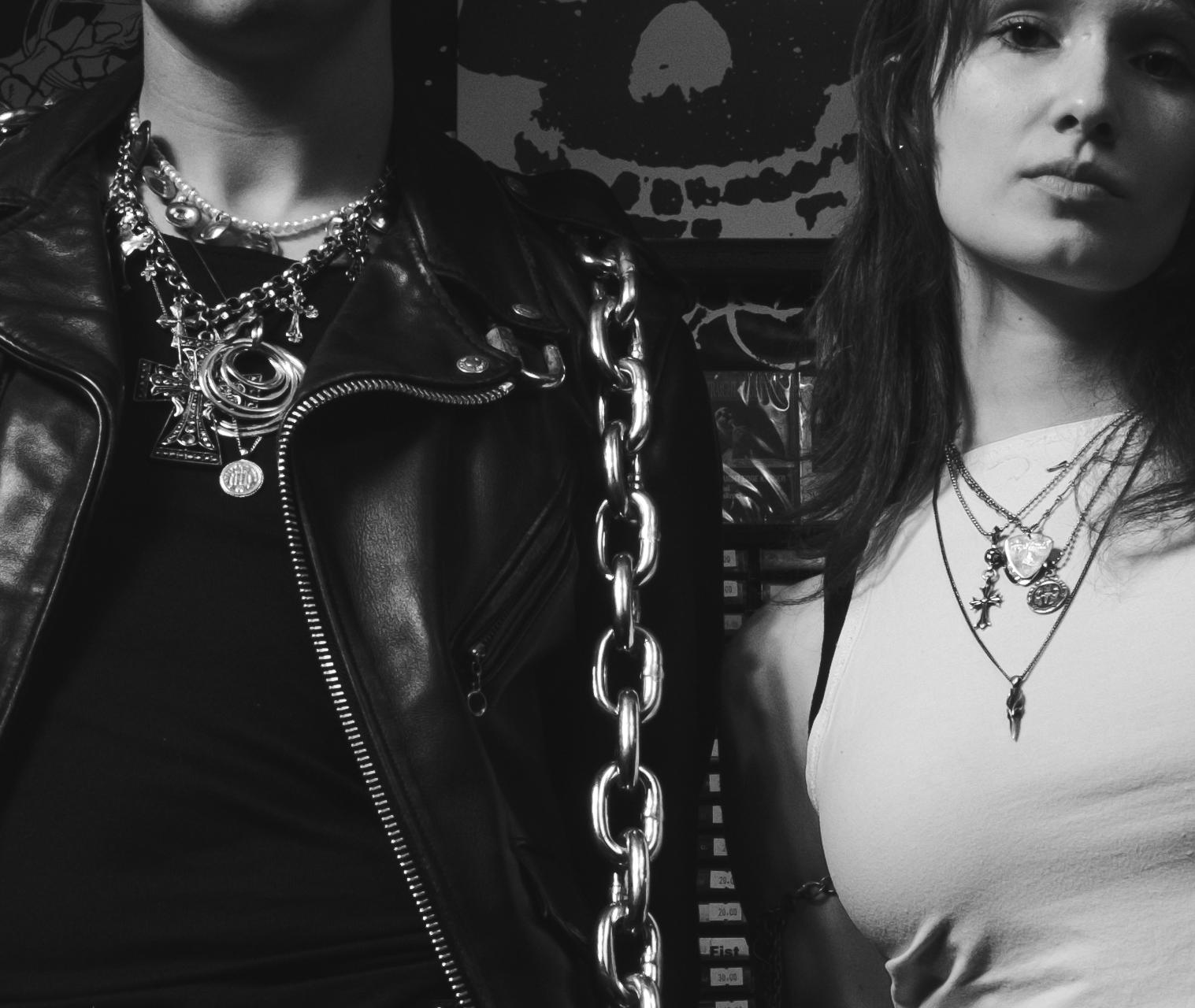
STRIPS OF CHAINS, BITS OF SILVER IN PLACES YOU DIDN’T KNOW POSSIBLE EXALT THE EXCESS; A COVEN OF CULTURE AWAITS YOU.
ALONE. WHO HAS YOU? WHO’S THERE FOR YOU? SILVER CAN PROTECT, BUT IT CAN’T FIX WHAT’S UNDERNEATH.




A DESPERATE SURGE OF EMOTION FLESHY RAW PINK PEEKS OUT WHERE THE REGALIA ONCE LAY. BARE. EXPOSED.

A BLAZE OF MOVEMENT AGAINST THE DARK OF NIGHT, SHINE LIKE DIAMONDS BENEATH THE CONED STREETLAMP LIGHTS.


YOU CAN RUN, BUT YOU CAN’T HIDE YOUR EYES SHOW THE ANGUISH. THEY KNOW THE EXHAUSTION. SLOUGHING OFF THE FINAL REMNANTS OF SILVER, LEATHER, AND DENIM THE REAL YOU. RED SKIN. HOT. IRRITATED AND SCARRED.





THEY’VE LEFT THEIR MARK ON YOU. OFFERED THEIR PROTECTION, AND TOOK THEIR POUND OF FLESH.

LEAVING YOU BARE. EXPOSED.

The unknown. The great unknown. So many years left and yet so few days. And the days. The days. So short. So fast and they keep coming. The world keeps coming. The hills are on fire and the children are crying. Never slowing. It never stops. And me. So small. At the absolute center of it all. Paralyzed by it. I need it to stop. All of it. Make it stop. I can't suffer it any longer.
I’m stuck. Wedged between the world and my mind. At war with my choices. A prisoner captive to my desire. Desires, out of reach. Crushed under the excruciating weight of a world that doesn’t want me, and a mind that wants it all; “CHOOSING ONE MEANT LOSING ALL THE REST.” Plath had it right. May as well lay. Luxuriate in my loneliness and indecision. Yes, that's the answer. Peace at last. The pen will no longer force my hand. I’ll no longer run down dead end streets. I was once a writer, not a very popular one, solitary to the world, populated in my mind. I’ve seen my dreams dashed and divided like the shrapnel collateral to bombs dropped on innocent villages. Each one burnt up in front

of my eyes before I had the time to grab it, roll it around in my fist, and understand what it took to bring it unto me. I’ve never made any progress. I remember something I read in a book once. It went along the lines of “sleep feels productive. It sorts something out.” The answers lie in stagnation. Progress toward peace. I’ve spent my life pining for what is just out of reach. And I’m done.
So I became an endemic disease of my bedroom. My unhinged hypnotic relaxation consumed me as I began to rot like a carrion left in the summer sun near a roadside truckstop. Dead meat. Limp. Lifeless. That is me. The garbage and disarray compounds outside and in. Piling. Piling. Up. up. Up. up. Up. A sad sack wallowing in lavish self pity, I cowered in the corner when I was first confronted by her light. She came like an angel in the



night, called to me like a siren from the sea. Brilliant streaks scattered around her figure illuminating the cave of my chamber. Like a reflection of everything good left in me, she helped me put the scattered pieces of my life back together. Her words broke through the dense haze of my cave in a dream state: “I am the one who you yearned for in the dark. The missing piece to your puzzle.” Within the confines of my room our relationship blossomed. In my dank, clutter-stricken prison she showed me I could control my environment, and brought the outside in. There is no more world. There is only me. And her. In these four walls. Forever. Confinement is all. Compartmentalize. Decompose. Derealize. It’s in my hands
now. This is my world and it’s in my hands. She showed me that. In her corporate skirt suit, like a vision of success I could never reach, She pulled my world back together inside of my isolation chamber. With a handy stopwatch, she showed me all the time I’d wasted in the outside world, thinking that one day I’d find my way. Now I know the truth. The door doesn’t open now. It never will again. I’m shut up in here against the world. Pure and peaceful. With Her. Forever.


Director of Layout

Directors of External Events


Directors of Internal Events
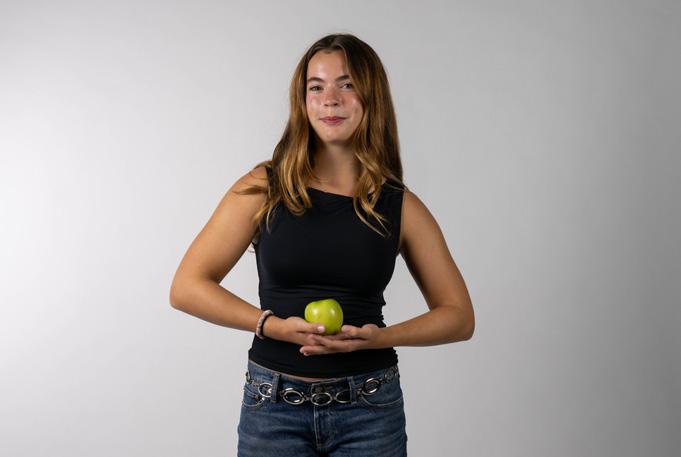
Directorsof Copy

Director of Social Media Project Managers

Directors of Styling

Directors of Finance
Not Shown
Director
Director
Claire Ackley
Tess Agoglia
Soobin Ahn
Saivee Ahuja
River Alsalihi
Priya Anand
Rayna Auerbach
Brian Babisa
Ria Bakhaya
Nina Bergman
Biswash Bhattarai
Emily Blake
Josie Blough
Gabriela Brenes
Kaila Brooks
Ellie Budde
Ashton Burgess
Anika Busick
Taina Cepeda
Nicolas Cevallos
Grace Chung
Aiden Cole
Maeve Collins
Ethan Crandall
Gabriella Cullen
Maya Dabney
Alexa Djalal
Tirza Elliott
Nicole Farnsley
Odin Flores
Sophie Floyd
Ja'la Fuller
Jared Garelick
Levin Garson
Lavina Grzymajlo
Tyler Hanson Mathur
Eloise Harcourt
Sylver Hart
Chelsea Haye
Bram Hoffman
Violet Holah
Hayzin Htike
Sofia Huitron
Natalia Jamula
Christopher Jung
Ashley Kim
Eileen Kim
Hera Kim
Joohee Kim
Noah Beck Kim
Seoeun Kim
Paul Kuemmel
Kate Kunitz
Emily Lapidus
Chelsea Lee
Erin Lee
Phoenix Lee
Jocelyn Liao
Emma Lichtman
Andy Li
Judy Li
Rose Liu
Sam LoGerfo-Olsen
Joshua Lorenzo
Elena Lucero
Fiona Lyons-Carlson
Ingrid Lyons-Carlson
Andy Mai
Sophia Maldonado
Myra Malik
Lara Isabel Marco Y Marquez
Ethan McCormick
Reid McVey
Riley Meltz
Michelle Mesnick
Cece Milde
Kannon Minnis
Mimi Milord
Ana Mitreva
Madison Morris
Lakshmi Mulgund
Gillian NevinsSaunders
Alex Nickel
Amaris Ninah
Christina Oates
Margo Ogrosky
Avery Ominsky
Chiby Onyeador
Evelyn Pae
Brooke Pan
Lydia Park
Sofia Perez
Chandra Phenpimon
Jess Piard
Anara Pollak
Faheem Rahman
Liora Raimondi
Natalie Rodriguez
Nina Rosell
Arielle Roybal
Zachary Ruwitch
David Schantz
Gray Scherma
Max Selver
Michaela Sewall
Alyssa Shen
Sharon Shen
Jakob Shenfeld
Lacey Shin
Whitney Short
Nora Silvergleid
Larissa Sitek
Seth Skiles
Olivia Slemmer
Camille Smith
Lauren Speicher
Ben Stull
Jialing Sun
Carolyn Tang
Aidan TaubenblatRoberts
Sarah Terry
Mira Ugwuadu Brynne Venneman
Jose Villicana
Brugada
Cami Vynerib
Andrew Wang
Grace Wang
Jackie Wang
Sophia Weinberg
Chloe Wetzler
Zoe Yang
Erika Yanou
Ryan Yin
Ashley Yoon
Jackie Yoon
Nissi Yorke
Talia Zakalik
Genavieve Zermeno
Kendra Zhong
Alison Zhu
This magazine was produced at Washington University in St. Louis in 2024–2025.
Special thanks to the layout team:
Fiona Lyons-Carlson, John Tischke, Joohee Kim, Sophie Floyd, Maeve Collins, Sofia Huitron, and Sophia Palitti.
Typefaces used include Helvetica Now, Instrument Serif, Harmonique, the Freight Text Pro family, Sloop, Syncro Pro, Acumin Pro, ABC
Maxi, Seplan, Astronef Std Super, Rockwell Condensed, & Tanklager.
Stay Superfluous. c

